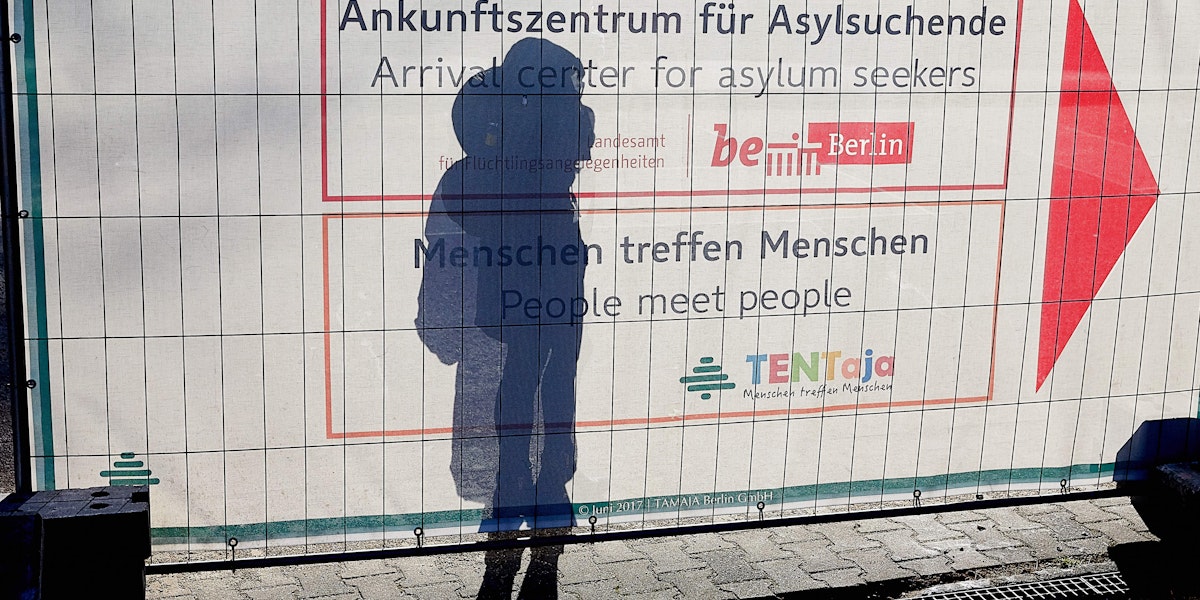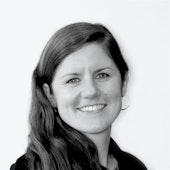In 2015 and 2016, millions of refugees from Africa, the Middle East, and Central Asia poured into Europe, stoking xenophobic fears in many countries, and even provoking some countries to try to close their borders.1 Meanwhile Germany—an economic powerhouse with a falling birth rate and a historic image to shed—threw open its doors to Syrians fleeing a brutal civil war that had left them unable to go to school, work, or lead any kind of normal life. Chancellor Angela Merkel removed a legal EU barrier requiring Syrian refugees to claim asylum in their first country of arrival,2 famously intoning, “We can do this!” in a message to her citizens.3 Since then, despite multiple changes to EU law, more than 1.4 million people have applied for asylum in Germany.4 The majority are Syrian.
Within a matter of years, Syrians have become the third-largest group of foreigners living in Germany (Turks are the largest, and Poles the second). Today, more than 700,000 Syrians are dispersed among Germany’s 82 million inhabitants.5 They are still a tiny minority, but the population has grown significantly—all but approximately 30,000 migrated after the Syrian uprisings began in 2011. The German government has developed a series of systems to integrate its new refugee population, and a momentous effort is underway by all parties involved: federal, state, city, and local governments, civil society, and of course the refugees themselves. Germany’s world-renowned vocational school system in particular is working to integrate refugees into the country’s workforce, a necessity due to a nationwide labor shortage.6 And numerous volunteer and nonprofit organizations have started new initiatives to help the integration process. But there are also those working to reverse Merkel’s welcoming policies on immigration, and the backlash she has faced was clearly evidenced by her difficulty forming a coalition after the last election, and the rise of the far-right, anti-immigration party, Alternative for Germany (AfD). Interior minister Horst Seehofer foisted a major challenge on Merkel in advance of an EU summit on migration in late June, but she managed to pull through, reaching a deal with neighboring countries to tighten security along the border with Austria and build border camps for asylum seekers previously registered in other EU countries.
On top of the bureaucratic and logistical obstacles, the challenges of societal integration facing the Syrian community are clear. For many Germans, integration means assimilation, while many Syrians are hoping to maintain their strong traditions from home. As in other European countries, the Muslim veil for women is a flashpoint, with Germans and Syrians alike conceding that women who refuse to stop wearing the veil are often seen by Germans as unwilling to embrace their new home, and will be considerably limited in their employment opportunities. Some Syrians feel frustrated at what they consider the patronizing attitudes of Germans who assume they have nothing to learn from the newcomers, but plenty to teach them (one interviewee called it a “one-way conversation”). Stricter policies on family reunification instituted in 2016 also made it difficult for some refugees to integrate, though in early August the government announced it would restart the process to bring in up to 1,000 direct relatives per month (some 34,000 requests have been lodged). 7 And of course there is the question of who will return to Syria and when, although with President Bashar al-Assad back in control of much of the country and implementing laws to prevent displaced people from returning to their homes, most are unlikely to return any time soon.8
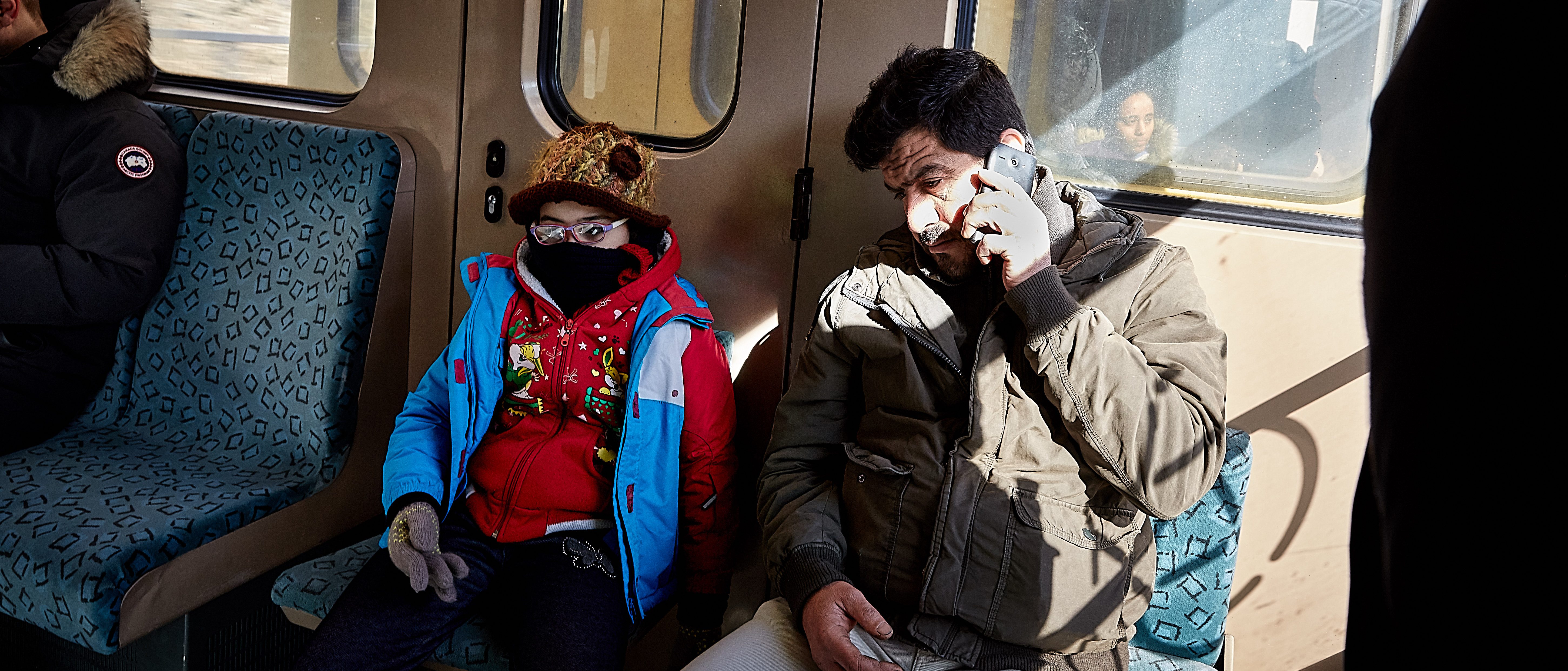
The German response thus far to the refugee crisis stands in sharp contrast to the current rhetoric9 and policies10 of the administration of President Donald Trump on immigration, particularly from majority-Muslim countries.11 In fact, Trump recently capitalized on an internal German conflict about migration policy reform to make false claims that the country’s crime rate had increased because of the refugees, which have “strongly and violently changed their culture!”12 Others have objected to the prospect of admitting asylum-seekers on practical grounds, arguing that it simply takes too much capacity to vet and absorb refugees.
This report is an exploration of Germany’s effort to systematically integrate its refugee population, with a particular focus on the Syrian community. The United States and other nations hosting large populations of refugees and other immigrants may glean some useful lessons from Germany’s experience thus far. The report is not meant to provide a comprehensive overview of the services being offered, or to generalize on the widely varied experiences of refugees. Instead, it offers a peek into the experiences of some of the people and institutions currently involved in these early stages of Syrian refugee integration in Germany, particularly regarding employment, but also other aspects and expectations of societal integration. It is based on site visits in the spring of 2018 to integration classes, vocational schools, places of employment, refugee housing, private homes, and nonprofit organizations hosting programs for refugees in Berlin, the German capital and largest city, as well as the Bavarian city of Würzburg and town of Kaufbeuren.
The report focuses on employment because one of the most common fears voiced by critics of Merkel’s open-door policy for refugees has been that supporting them will be a drag on the German economy, and that they will not be able to integrate into the workforce. But with tens of thousands of refugees already enrolled in integration classes at the country’s reputable vocational schools, it is clear that government authorities are purposefully laying out a path to employment for the new members of their society. Indeed, a recent report by the state-funded Institute for Employment Research (IAB) said that refugee unemployment had fallen ten percentage points over the past year, and that at this rate half of the refugee population that arrived in 2015 would be working by 2020. Refugee unemployment now hovers at 40.5 percent (overall German unemployment is at around 5 percent).13 In addition, the number of refugees entering tradecraft apprenticeships, both through vocational school and otherwise, has increased 140 percent over the past year.
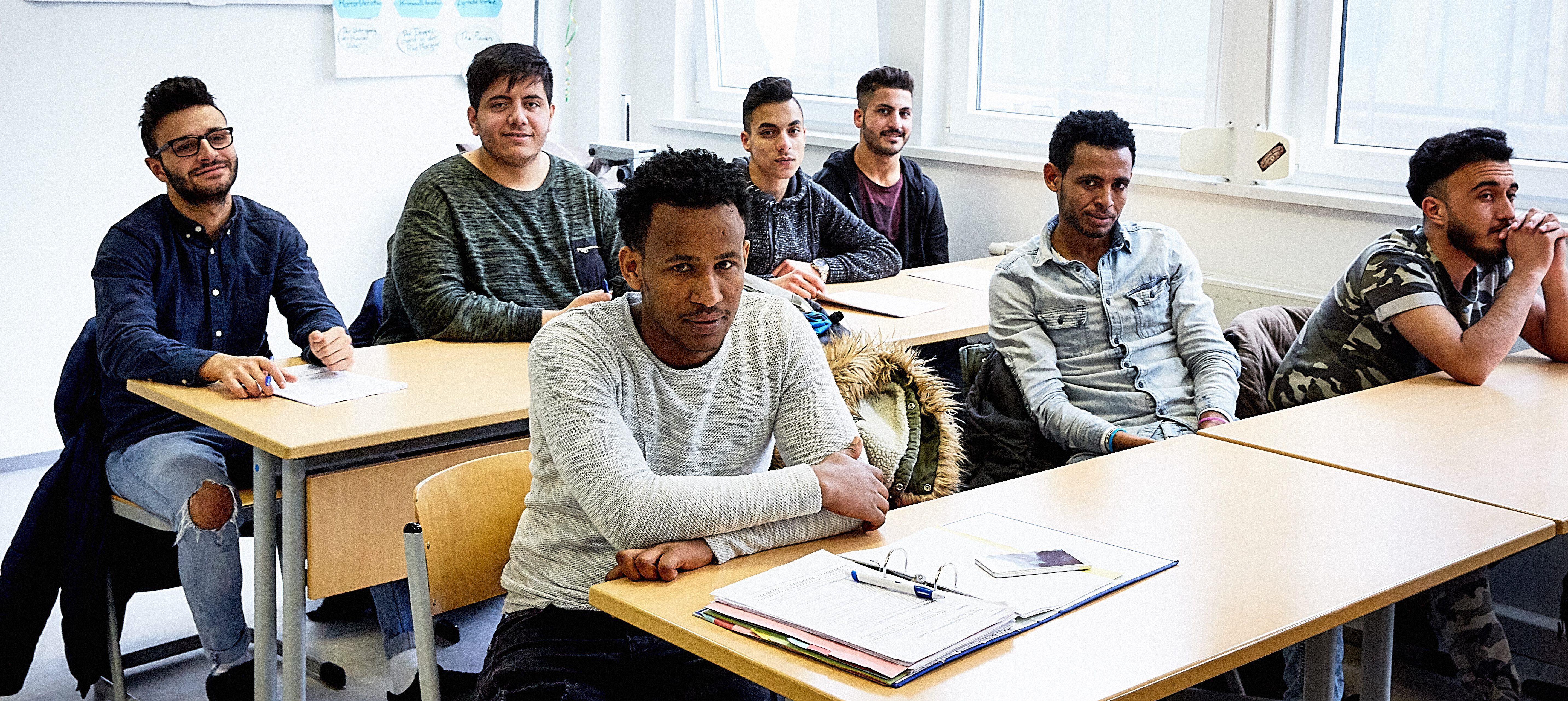
With support from the Carnegie Corporation, the author traveled to Germany and conducted dozens of interviews with Syrian refugees, German nationals, and other foreign-born residents of all different socioeconomic backgrounds about their experiences with the integration process in recent years. After a brief look at Germany’s earlier experiences with large influxes of immigrants, the report examines several aspects of Syrian integration into the German economy and society, particularly workforce integration via Germany’s robust network of vocational schools and integration classes, with a focus on the case of Bavaria; other routes to employment, such as through low-skill jobs, higher education, and program efforts by civil society and volunteer organizations; and societal integration, with a special look at some of the common threads in conversations with Germans and Syrians about how they are learning to live together.
Taken together, the report offers an account of what a determined government can accomplish if it commits to a policy of welcoming a massive influx of refugees. While Germany’s experience so far is checkered, on the most important counts, it has been a success. Fears that refugees would spur an increase in terrorism proved unwarranted. So did worries that the refugee influx would derail Germany’s economy. Despite the tensions and setbacks detailed in this report, Germany has managed to reap national benefits from a welcoming policy, implemented despite major political, economic, and social risks.
Learning from Past Mistakes
Germany has experienced large influxes of immigrants before, but it has never made such a concerted effort at integrating them into the population. Merkel has said that the country should learn from mistakes made in the past, largely referring to its experience with Turkish immigration.14 In 1961, facing a labor shortage, Germany signed a contract with Turkey to bring in hundreds of thousands of “guest workers,” but offered no German language courses or vocational training to help improve their skills. German officials mistakenly assumed that the workers would return home after their contracts finished, but instead many brought their families and stayed even as Germany entered an economic recession in the 1970s. Turks wound up clustering in certain neighborhoods (Kreuzberg and Neukölln in Berlin are two of the most well-known), and today the 2.5 million people with Turkish background in Germany15 are considered the least integrated minority in the country, with unemployment at around 16 percent.16
The experience of Turks in Germany looms large for today’s Syrians and their efforts to assimilate. During a community language exchange session in the town of Kaufbeuren, a Syrian resident explained, “I think the government doesn’t want the Turkish style, they want us decentralized… the government wants the Syrians everywhere. Not one million in one city, and no Syrians in another city.” A German resident chimed in: “We don’t want the danger of parallel societies.”17
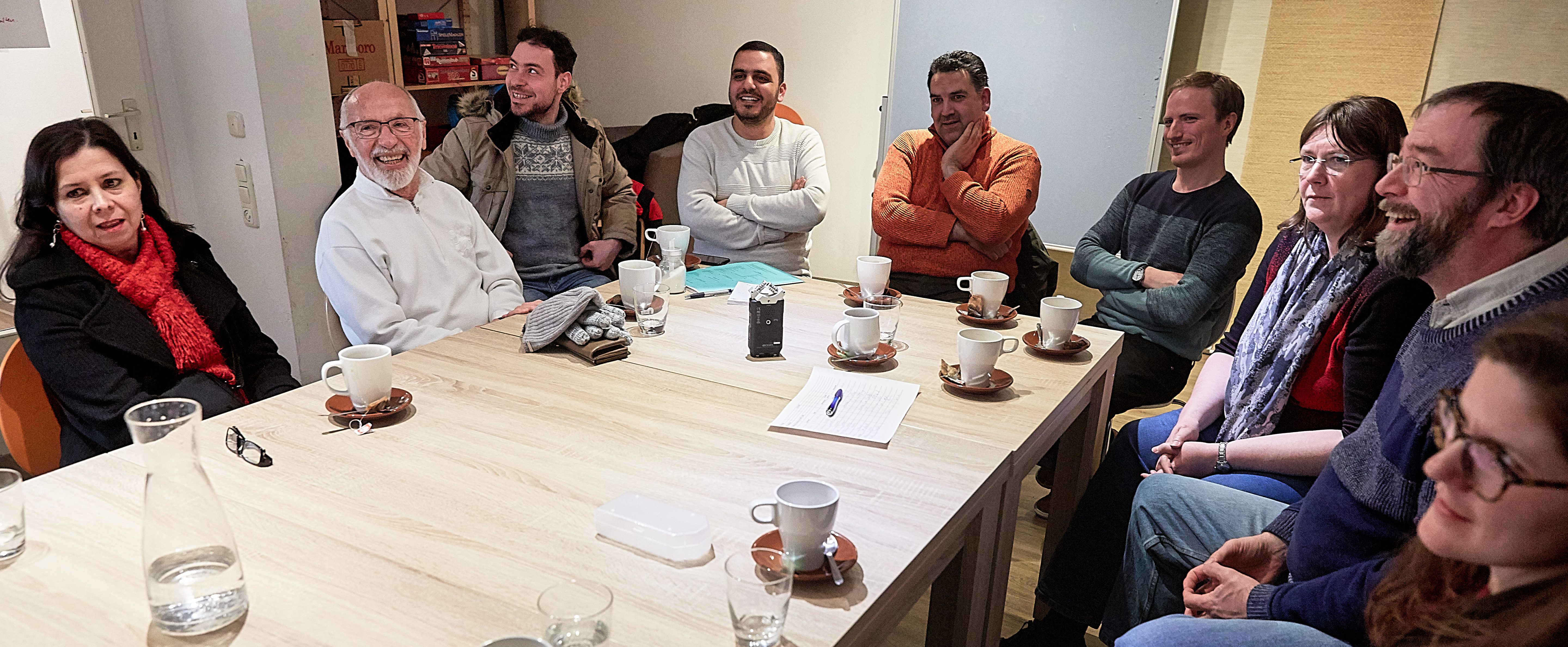
Audio: At the Deutsch Stammtisch, or “German table,” Syrian refugees and other newcomers practice their German language with local residents. This clip includes comments from Kaufbeuren residents Abdulrahman Alzghaer, a refugee from Syria, as well as Faruk Sevimli, Jurgen Konrad, and Norbert (last name withheld), and the author and photographer.
With the recent influx, the German government developed a series of systems to integrate the refugee population. No matter which border they cross to enter the country, federal authorities “fairly distribute” all refugees throughout Germany’s sixteen states using a calculation of the states’ tax revenue and population.18 All Syrian children with asylum status are eligible for government-provided schooling.19 Many teenage and adult refugees are currently enrolled in government-run “integration courses” which focus mainly on German language instruction but also include modules on the country’s history, law, and cultural norms. There is a plethora of public information, including instructional videos, for refugees to help them navigate the German bureaucracy.20
It is still too early to say how much these government programs will cost the German government in the long run, and whether the economic boost of the new refugee labor force will outweigh the cost of integration. Aydan Özoğuz, Germany’s commissioner for immigration, refugees, and integration, predicts that most refugees will take around ten years before entering the job market.21 But German government figures put the amount spent in 2016 on refugees at about €20 billion,22 and a Der Spiegel report published in May citing official documents estimated expenditures of about €78 billion through 2022.23 The International Monetary Fund predicted in 2016 that Germany would spend no more than 0.35 percent of GDP on asylum seekers.24
Experiences vary between states and localities depending on politics and the local population. The Federal Office for Migration and Refugees (known by its German acronym BAMF) is the first point of official contact for all refugees,25 processing asylum applications and administering asylum, welfare, and unemployment benefits.26 State and local governments are responsible for maintaining initial reception centers and administering health care, education, and housing needs.27 Volunteers and civil society often fill the gaps to make sure these more quotidian needs are being met, but that varies widely across the country. The former East Germany, where per capita GDP lags behind the West by 27 percent28 and anti-immigrant sentiment seems to be strongest (based on AfD support),29 hosts fewer refugees than the former West Germany and Berlin (which is located in the east). In parts of Berlin and some of the former West German states, support for refugees by civil society and volunteers is more robust and organized.
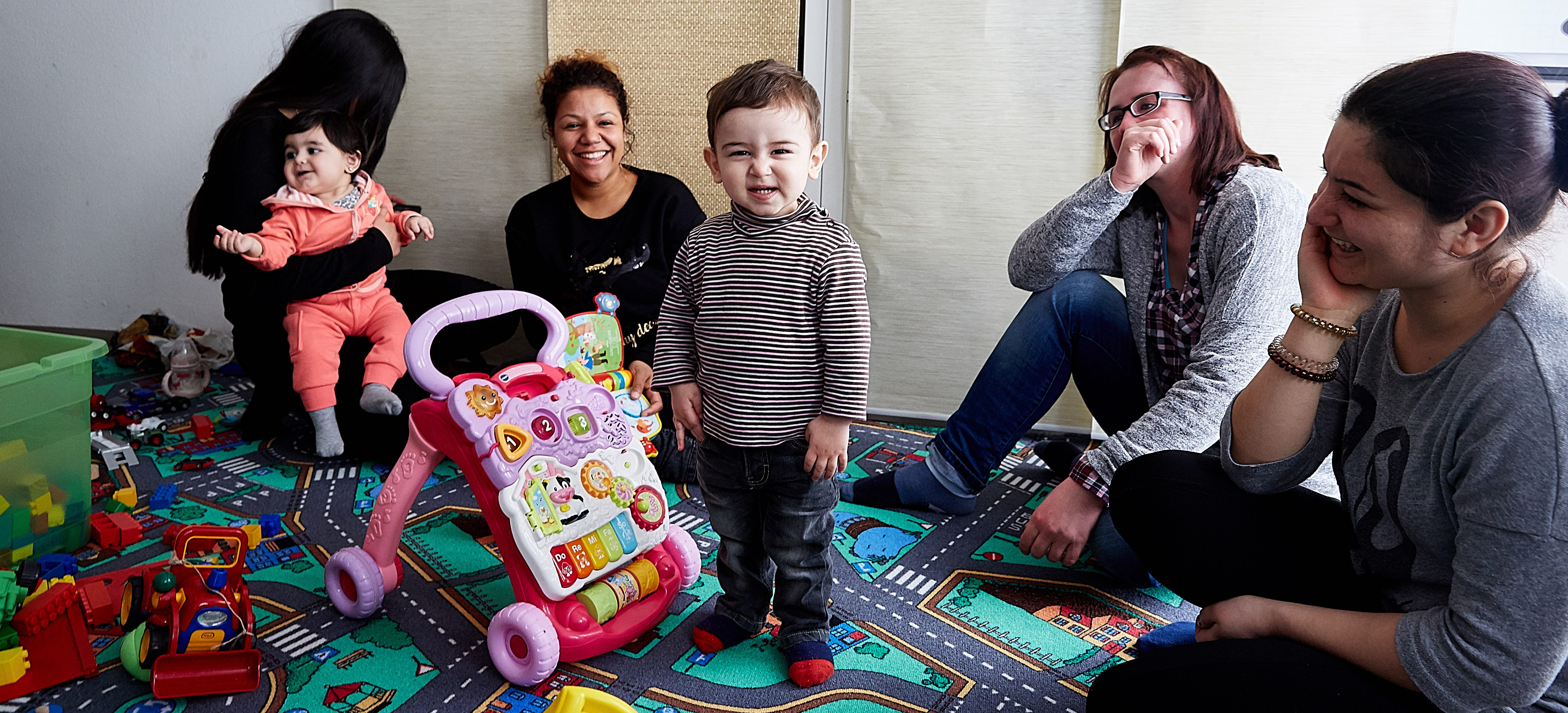
Arbeitskreis Asyl Kaufbeuren30 is one example of a highly organized group of volunteers in Kaufbeuren, a small Bavarian town of 45,000 people, but Günter Kamleiter, spokesman and co-founder, believes they are unique given their comparatively long history.31 The group was organized by local members of Amnesty International along with the town’s churches in 1989 when Kaufbeuren had its first influx of refugees, from Bangladesh, India, Turkey, and the far east. They have run a weekly gathering known as the te stuben, or “tea room,” since 1991 for refugees to connect with local residents. The group helps refugees find housing and jobs, as well as navigate the bureaucracy. It also organizes programs like the Deutsch Stammtisch, or “German table,” for newcomers to practice their language skills, and Sprachurabbel Gruppe, or “speak and crawl group,” for mothers with infants and toddlers.
Audio: Günter Kamleiter, co-founder and spokesperson for volunteer organization Arbeitskreis Asyl Kaufbeuren, describes the weekly “tea room” gatherings he has run for refugees and local residents in the town since 1991.
Some already-established refugees in Germany have also formed groups to help other refugees. Abdulrahman Alzghaer and his friends in Kaufbeuren started a private Facebook group called Zusammen, or “Together,” to connect the community and assist newcomers with their daily lives: searching for doctors, providing legal advice, or helping register children in school. A similar organization known as Salam-Kultur was co-founded by Syrians and Germans in Berlin.32 There is also a network for refugees working in media in Berlin called “Media Residents.”33
Workforce Integration through Vocational Training
Germany’s world-renowned vocational training system is often touted as the engine of the country’s economic success.34 It is also a centerpiece of the country’s first national integration law, and is seen as key to bringing refugees into the German workforce.35 However, for most Syrian refugees, who have only been in the country for two or three years, time is still needed to overcome the language barrier before securing the coveted apprenticeship—one of the best ways to secure permanent employment. New policies and programs have been implemented to help smooth the transition process.
Also known as the dual system, because it combines three to four days of on-the-job skills training with one or two days of theoretical classroom-based learning each week, students enter vocational training as a route into employment in trades including gastronomy, watchmaking, geriatric care, and auto mechanics. It is much more highly esteemed in Germany than it is in the United States, where it is also much smaller (though President Trump has expressed interest in expanding vocational training programs,36 and his daughter and senior advisor Ivanka Trump visited the Siemens training facility in Berlin last spring).37 But the vocational school administrators interviewed for this report said that their popularity is decreasing as more importance is placed in Germany on going to university. They hope refugees will soon begin to fill the void, and statistics show that they already are—in 2017, more than one in ten apprentices in the non-trade sector in Bavaria was a refugee.38
The integration law, which entered into force in August 2016, stipulates that those refugees who find a firm to employ them may not be deported during the three-year vocational training period. If the trainee is offered a permanent position after the training period, he or she will be granted a two-year residence permit. The law also eliminated the age limit of twenty-one because refugees tended to be older. The so-called “3+2 rule” and lack of age restriction makes the apprenticeship a prized opportunity for the increased numbers of refugees, and many interviewed for this report spoke of it as a goal after improving their language skills.
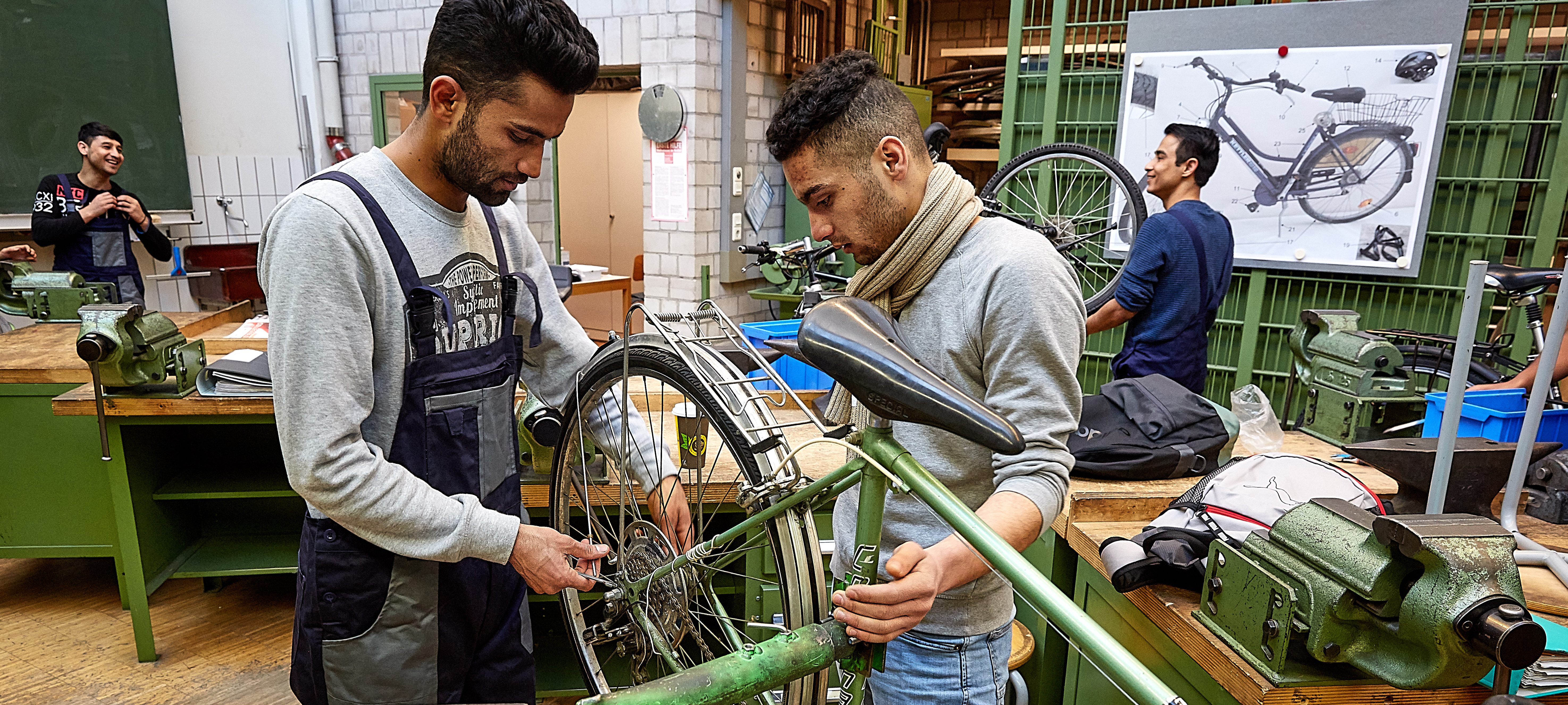
However, that will take time. As evidenced by a recent intergovernmental survey of German employers,39 language skills among refugees generally are not yet at the desired level. Most have been in the country for just two or three years, so it is no surprise that more language training is needed. An English teacher at a vocational school in Würzburg said in an interview the companies “desperately need people, but most of those refugees or asylum seekers are not really ready—language is still a problem and also they do not have the skills.”40 So vocational schools are being tasked with offering vocational language training as a way to speed up the labor integration process.
Another piece of the national integration law was to increase the number of mandatory, cost-free “integration courses” being offered.41 Since 2005, German immigration law has required all immigrants from non-European Union countries to participate. The courses include 600 hours of German language instruction and a sixty-hour “orientation course” including information on German law, history, culture, and values. In 2010, demand for integration courses was already outstripping supply,42 and there were only 140,000 students. By 2016, that number had almost doubled to 246,125, just under half of whom were Syrian.43
At Hörgeräte Baur, a hearing aid center in the historic district of the Bavarian town of Kaufbeuren, twenty-one-year-old Wael Kojo from Aleppo is one of the lucky few refugees in the country to have already landed an apprenticeship. Kojo has been enrolled in integration classes at the state vocational school in Kaufbeuren since 2016, and will finish this fall so that he can work full time at Hörgeräte Baur. Founder Steven Baur said Kojo’s German language was far above most other non-native candidates.44
Challenges Faced by Bavarian Vocational Schools
The experience of vocational schools in the southern state of Bavaria, the main migrant entry point into Germany, is one example of how much time and energy has been invested by state and local governments to integrate the refugee population. Bavarian vocational schools began to organize a version of integration courses in 2010–11, when there were only about 100 qualifying students. By 2015, the numbers had risen such that all vocational schools in the state were required to host the integration classes. By school year 2016–17 there were 22,000 refugee students at vocational schools in Bavaria.45 Bavaria has the second-largest economy in the country and one of the largest in Europe, so for refugees it is seen as a region of opportunity. BMW is headquartered there, as are Siemens, Audi, Adidas, and Allianz. The two vocational schools visited for this report were in Bavaria, in the city of Würzburg (pop. 124,000), which made international news in July 2016 when a teenage Afghan refugee armed with an axe and a knife injured four people on a train nearby, and the town of Kaufbeuren (pop. ~45,000), about an hour by train from the state capital, Munich.
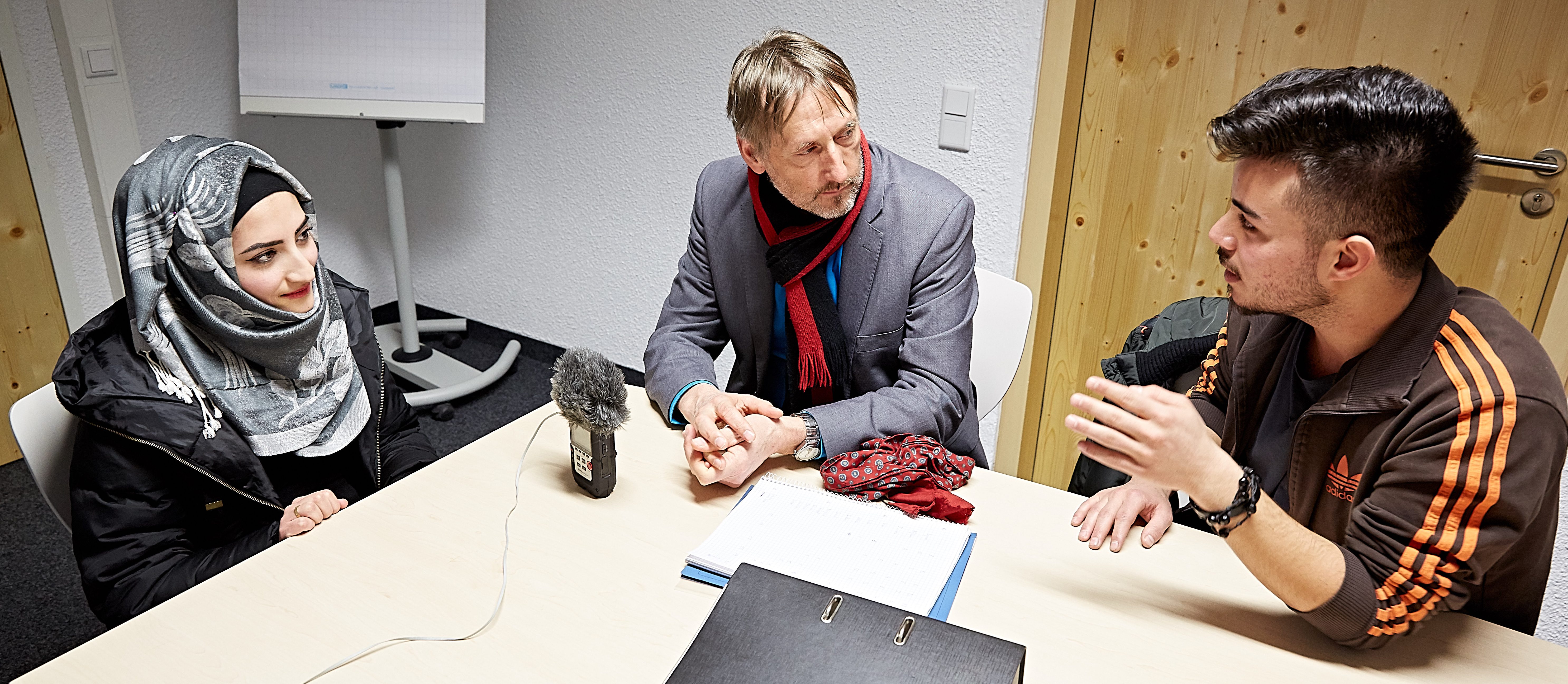
The Franz Oberthür Professional School in Würzburg reflects Bavarian wealth, with auto mechanics students practicing on the latest models of BMW and Mercedes Benz, heating, ventilation, and air conditioning (HVAC) apprentices using new robotic equipment, and a graphic design department that recently acquired state-of-the-art printers. The school started accepting refugees in 2014, and there are currently 160 refugee students from forty-one countries enrolled in integration classes at the school, though most are from Afghanistan and Syria.46
Franz Oberthür’s headmaster, Uwe Tutschku, said that the school’s first year with refugee students was extremely difficult. The biggest problem was finding teachers that were capable of teaching German as a second language, and finding teaching materials for students from such different backgrounds. Many students came without any documentation at all about their age and former schooling, some came with little or no formal education, some came with technical skills already, and some left without a word after only a few weeks of classes. Funding was a problem, because “the government was not organized for so many students, and who pays it, and how does everything work… so you had to get started and nobody knew where the money was coming from.”47
Audio: Uwe Tutschku, the headmaster of the Franz Oberthur Vocational School in Würzburg, speaks about the challenges of integrating refugees into the German workforce at this early stage (with English translator).
The state vocational school in Kaufbeuren (Staatliche Berufsschule Kaufbeuren) has also struggled to accommodate its refugee student population. They did not have enough space to accommodate the 160 students they initially took in, so they had to erect temporary classrooms in shipping containers next to the school. They also increased to two teaching shifts. School administration official Markus Schiele, who took in a fifteen-year-old Afghan boy as a foster child in 2015 and housed him until he turned eighteen, recounted stories of the constant deportation threat faced by the Afghan population at the school. After news spread that the federal government was preparing a deportation flight to Kabul, a student asked Schiele if he could stay overnight at the school.
“They are in a state of insecurity and that is of course very strenuous, very hard for them, and also then hinders the learning process,” said Schiele. “If you don’t know whether you will be here next week, why should you learn German?”48
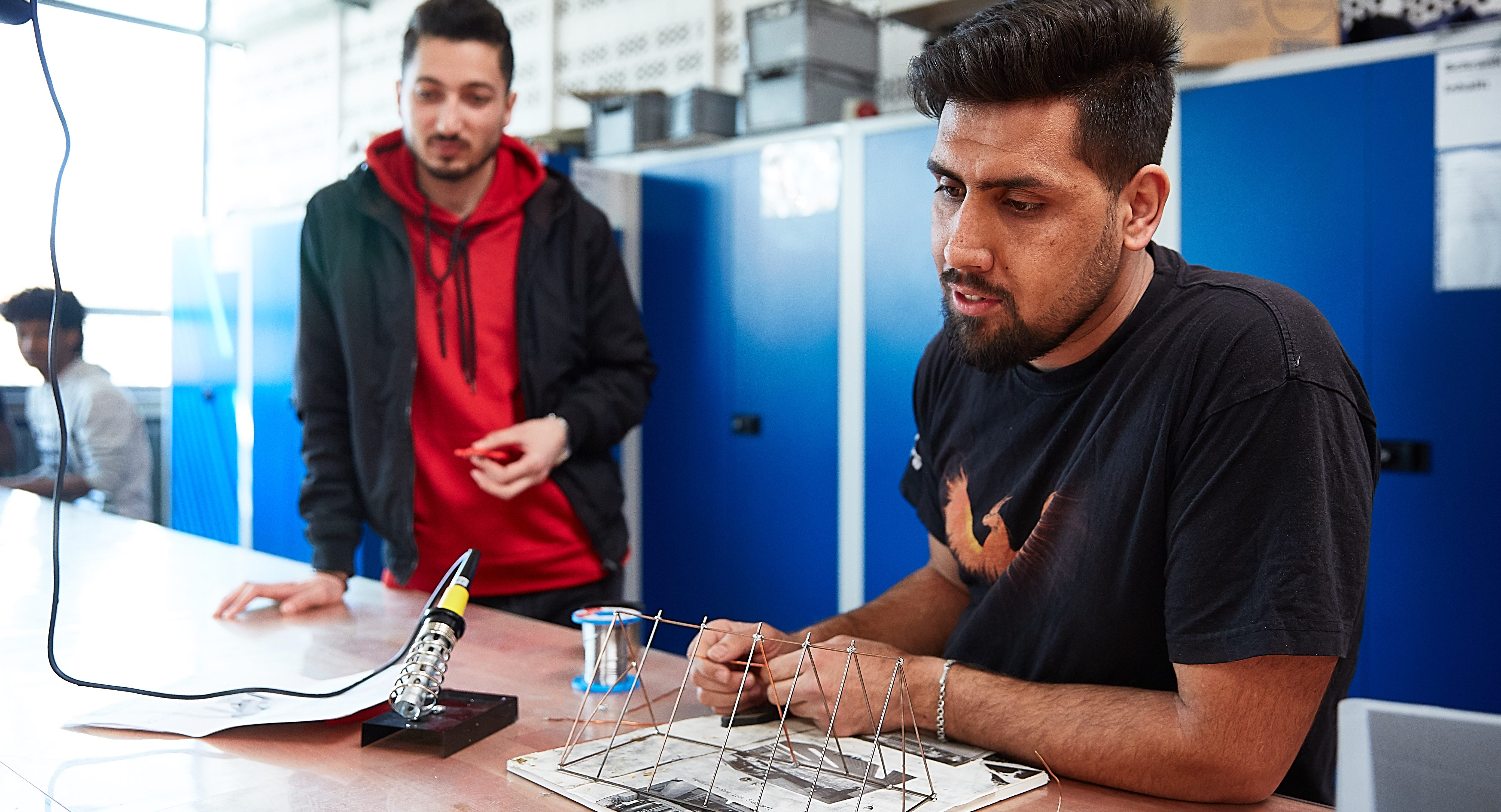
Both Tutschku and Schiele said it has gotten easier each year, but there are still challenges. Some students have trouble finding a place to live. Some struggle with disease or trauma. Both schools maintain half-time social workers, which administrators agreed was not enough. For the students who were not used to going to school, it has been a challenge for them to adapt to the daily schedule and the homework expectations. The national integration law says government benefits will be curtailed for those students who refuse to attend integration classes without good cause, and Schiele said that they had arranged with the social welfare agencies for a dock in students’ monthly allowance or food vouchers if they miss too many days of school. Both administrators complained that some of the male students, particularly from Syria, resist treating female teachers as authority figures. At Franz Oberthür, the cafeteria tries to offer vegetarian options, but as vice principal Ralf Geisler said, “Integration means come together—not to change our system for the refugees.”49
In the beginning, according to Schiele, “I had the idea that they would come here highly educated and we would just have to teach them some German and then they can start the training. Big mistake… Car mechanic in Eritrea is something completely different, or in Syria, from a car mechanic in Bavaria or in Germany or in Europe. Because a car mechanic there will change the wheels and so on and then take a hammer if there’s a dent and so on then repair it, and a car mechanic here in our countries, they have to know how to use computers and so on to analyze what’s happening with the engine. It’s completely different.”
Audio: Markus Schiele, a member of the Kaufbeuren state vocational school administration, explains the program of the school’s integration courses for refugees.
The integration classes at Franz Oberthür and the Kaufbeuren vocational school are two years long, with the first year focused on language training and a “first orientation” where they can get an idea of what their talents are. A trade teacher is paired with a German language teacher so that the students learn skills at the same time that they acquire language. In the bicycle repair workshop class I visited at Franz Oberthür, Adnan, a twenty-three-year-old from Damascus wearing work overalls and holding a wrench, was referring to a vocabulary worksheet to explain to his teacher that he had “adjusted the gear here and it is now in working order.” In the second year, students do a series of internships to get an idea of which career they might like to pursue. Kosai Alsaleh, a second-year student from Raqqa working on a soldering assignment in a metalworking class at the Kaufbeuren vocational school, said he had completed an internship at a restaurant but his real goal was to be hired as an auto mechanic’s apprentice. Another student who said he worked as a tailor for eight years in Afghanistan complained that he had already sent in a number of applications to be an electrician’s apprentice but hadn’t yet received any responses.50
At the Kaufbeuren vocational school in a second-year German language class, eighteen-year-old Betul from Homs was reading aloud a letter she had written in German to Syrian president Bashar al-Assad for a class assignment. “For the last five years without any home I had to try to live in countries that are completely foreign to me, have to start a new happy life, have to learn the culture, everyday life, language, have to cope with the weather, and that is only a few of the things I had to learn from scratch,” read Betul. Her teacher, Diana Derner, said Betul was a strong student and her German was very good.51
“I have been teaching these students for almost five years now,” said Derner. “I’m really, really impressed by what these students actually have to conquer and what they’re doing… It’s really impressive for me how much courage they show themselves and how much they throw themselves into this new, completely foreign culture, with all their experiences—bad experiences—that they had.”
Audio: Eighteen-year-old Betul, from Homs, reads aloud a letter she wrote a letter to President Assad in German in front of her integration class at the Kaufbeuren state vocational school (teacher Diana Derner provides English translation).
Tutschku said that it was too early to say whether their students have been successful at entering the workforce, but he believes that the effort has been earnest. “We have the first refugees in the dual system but we don’t know how successfully they can complete it,” he said.
“I think it’s a good investment, because we would have more problems if we didn’t do it. So it’s better doing that than doing nothing, and then we would have many, many people living here without integration and no job opportunities at all. So we think it’s worth it in the end.”
Low-Skill Labor in Berlin
Germany’s creative capital, Berlin (sometimes referred to by Germans as “poor but sexy”), has attracted refugees whose interests or skills don’t fit neatly into the structured vocational training system. Berlin’s administration was widely criticized for being disorganized and inefficient during the initial influx of refugees in 2015–2016, and a plethora of volunteers and civil society organizations stepped in to help out.52 Many in Berlin’s strong network of arts organizations, as well as in international startup companies, especially in the tech industry, offer programs specifically for refugees. Very few have been accepted into university programs in Berlin. In addition, many Syrians have found job opportunities in Berlin’s well-established Arab and Turkish neighborhoods through family and community connections. Pop into any of the Arab restaurants, cafes, and pastry shops dotting the famous Sonnenallee street in the neighborhood of Neukölln and you are likely to find at least one Syrian refugee among the employees, if not even among the owners.
“Before the refugees came to Germany [Sonnenallee Street] was nothing, just two or three shops … and it was maybe ten people coming each day for this street,” said Ahmad, twenty, who came to Germany two years ago from his hometown of Aleppo and is managing his uncle Anas’s shawarma restaurant, Yasmin al-Sham (‘Syrian Jasmine’) until he can start school this fall. “Now you can see people coming every day—one thousand, two thousand, three thousand people coming every day to this street!”53
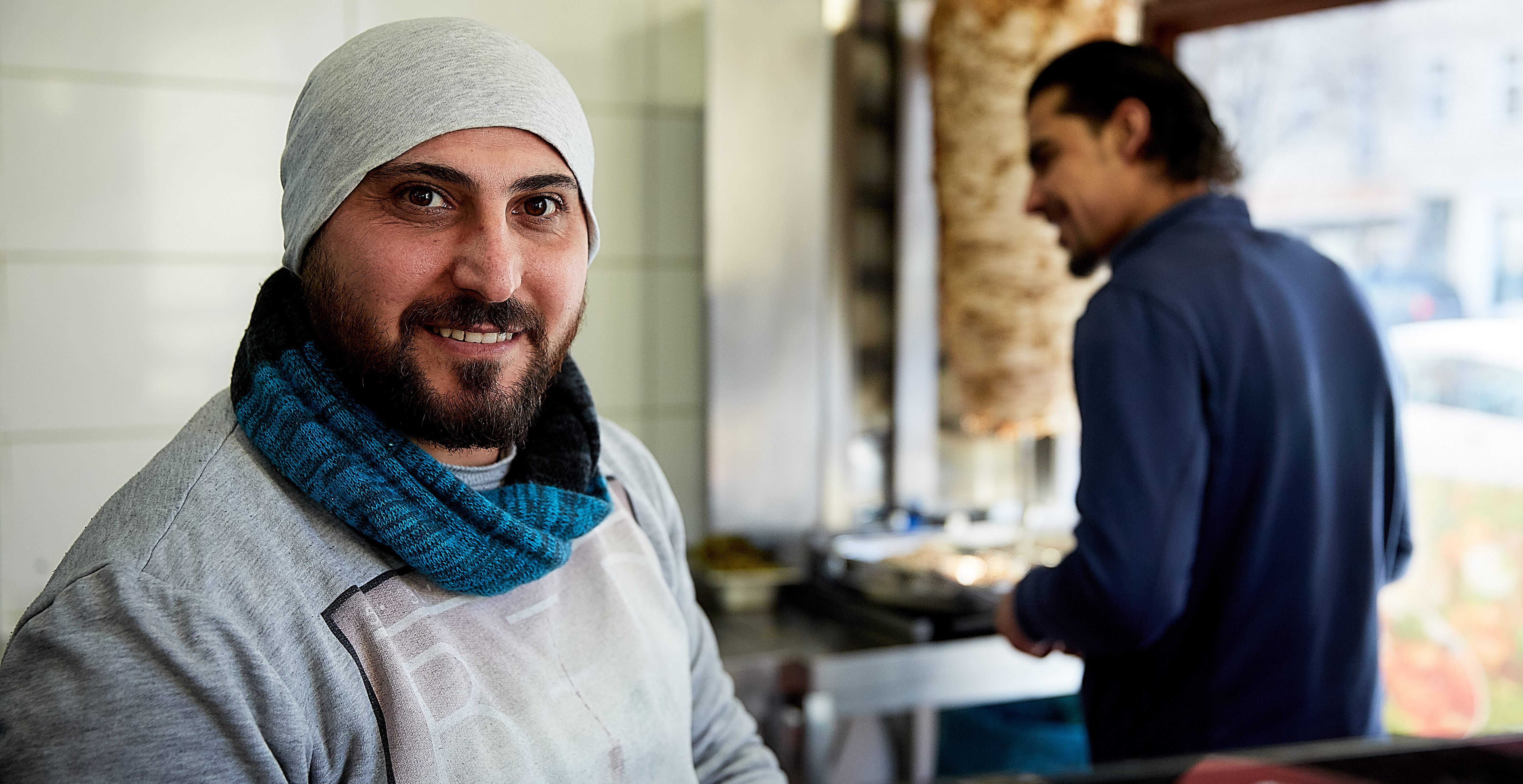
Not too far up the road, a refugee-run Syrian restaurant called Kreuzberger Himmel (‘Kreuzberg Sky’) opened in early 2018 thanks to the help of the “Be an Angel” refugee support organization that was founded in 2015 by a group of German journalists, marketing specialists, and artists. The so-called “gastronomic integration project” serves up delicious, authentic Syrian specialties in a simply decorated space with photos of Aleppo lining the walls.54 It offers apprenticeships and internships to refugees looking for work with goals that are, as outlined on their website, “very pragmatic: We do not want a parallel society. We do not want paying taxes for people who want to and can work. We are looking for the enrichment that every single person who arrives and integrates here has to offer.”55
Kreuzberger Himmel bartender Yazan Albaour left Damascus in 2012 and spent time in Turkey and Lebanon before finally finding a smuggler who agreed to bring him to Greece even though he was broke. His form of payment: Driving the boat.
“It was fun to drive something for the first time,” said Albaour, twenty-four, showing me a selfie he took on his cell phone from his position at the helm of a crowded nine-meter inflatable boat. “All the passengers in the boat wanted to pay me for getting them there safely, so they paid for my train rides all the way to Germany.”56
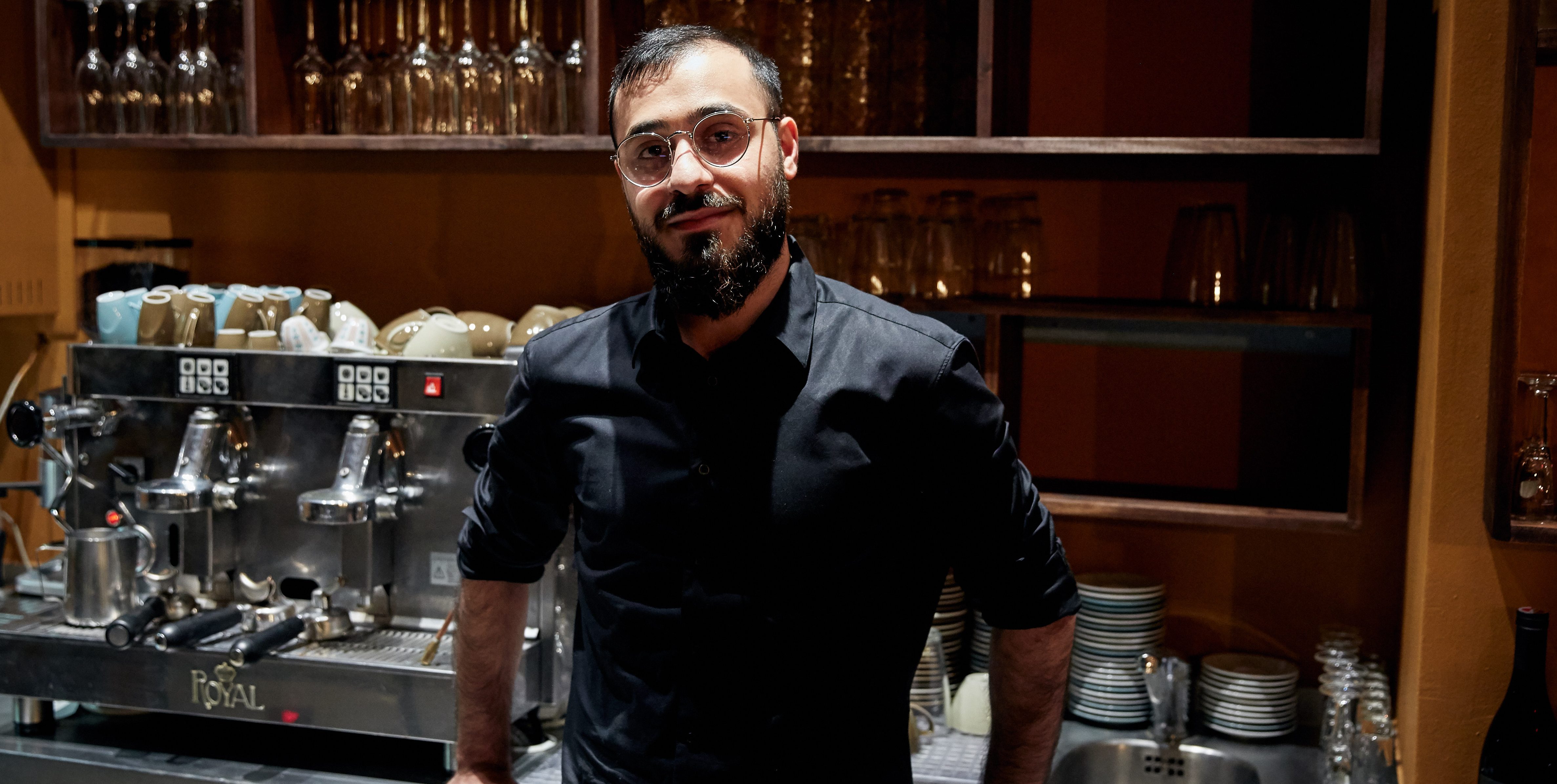
Higher Education
Refugees from Syria are relatively well-educated, with estimates by the German Agency for Labor in early 2016 showing that more than 50 percent of them had at least secondary schooling, and 27 percent had more, if not necessarily a degree.57 Fewer than 3 percent had no formal schooling. However, largely due to the language barrier but also to other factors, enrollment in German universities has been low, with only 1,140 refugees enrolled in the 2016 winter semester, the majority of whom were Syrian.58 The government has dedicated €100 million through 2019 to help increase refugee enrollment by providing preparatory courses and free applications, and by increasing funding for assessment programs to determine eligibility.59
Albaour’s friend Mohamed Alhalabi, a twenty-seven-year-old dancer from Damascus, said that Germany has allowed him to fulfill his dream of going to university, something he had previously considered impossible given that he had dropped out of school at age twelve. Alhalabi, who goes by the stage name “Wolf” and speaks near impeccable English, was accepted this year into an intensive three-year bachelor’s program at Berlin’s University of the Arts (Universität der Künste, or UdK). The teachers at his audition told him he was “an exception as a talented artist,” so the school waived the documentation requirements. He had performed for years across the Middle East as a professional dancer with a Beirut-based company before coming to Germany. For Alhalabi, the German system and approach toward immigrants is very clear.
“Here in Germany, work or education are the main things. Either you work, or you study. There is no third option,” said Alhalabi.60
As a student at UdK, Alhalabi has a key to a university recording studio full of prime equipment. He often brings Albaour and his other friends from Damascus, twenty-three-year-old Tareq Assad and twenty-three-year-old Odah Bashi, with him to the studio. Albaour is a cameraman and is learning how to produce beats, Assad is a rapper and Odah Bashi, who is also a server at Kreuzberger Himmel, is an illustrator. Together, the group is using UdK’s facilities to make a music video for a song Assad wrote about his brief marriage and painful divorce to a German lawyer he met in the West German city of Essen, where he was assigned upon arrival and lived for nine months. He is planning to apply to UdK this year.
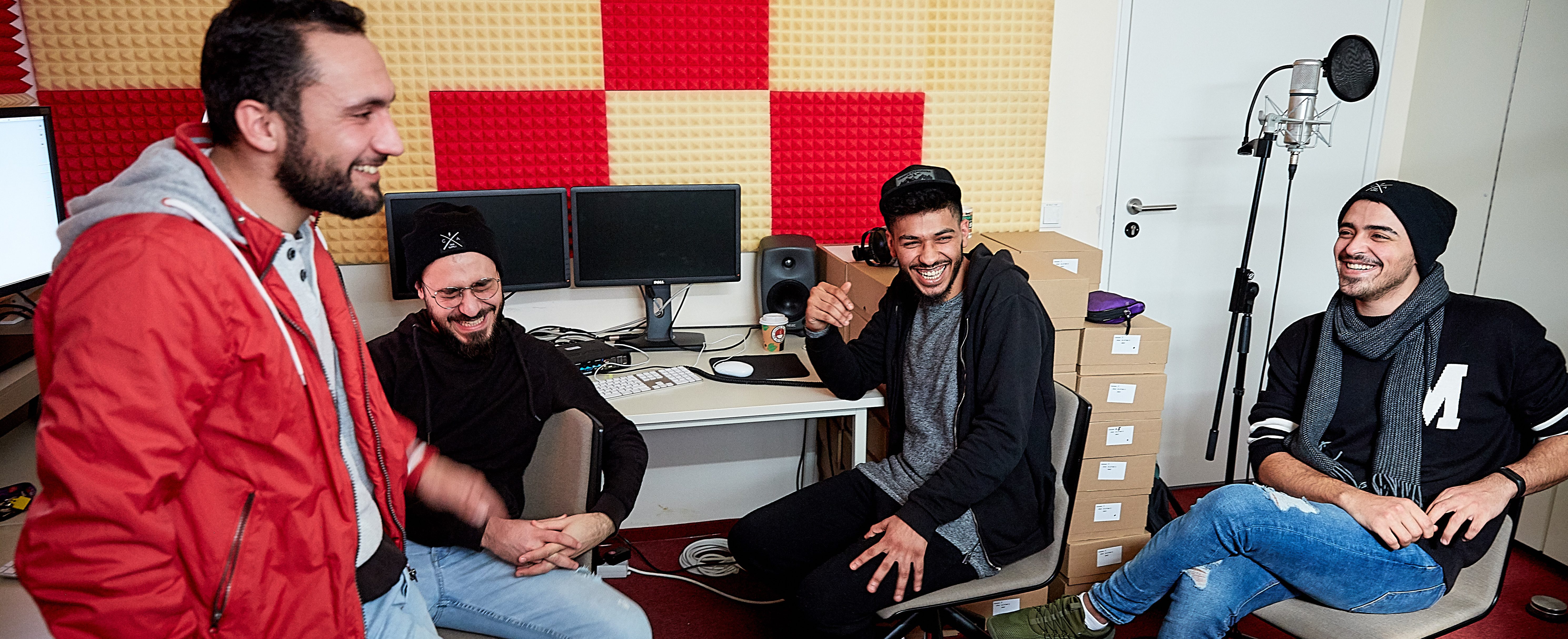
Audio: Syrian refugee Mohamed Alhalabi (“Wolf”), a student at Berlin’s University of the Arts, at the recording studio with friends from Damascus Tareq Assad, (“Mr. T.,” heard rapping), Odah Bashi, and Yazan Albaour.
Moutasem Alkhnaifes, twenty-eight, arrived in Germany in 2014 and went on to complete a master’s degree in urban management in Berlin thanks to a scholarship from the German Academic Exchange Service (DAAD).61 But he realizes that his case is unique. “I’m one of the lucky few who were able to go into university [in Germany] in the first place…. I was able to apply because I was able to get my papers from the university in Syria. I did leave in a rush but I was able to get those papers with me, and other people were not able to do that. I mean, if your house is being bombed, you would not be able to go to university and ask them for a duration of your grades for the last couple of years,” he told me.62
Alkhnaifes said that it was near impossible to live in Berlin on the €700 monthly student stipend. He paid €400 per month for a “tiny room” (one of the biggest problems in Berlin, and across the country, is affordable housing), plus €100 in health insurance, which goes up to €200 when he turns thirty. That leaves only €100–200 each month to spend on groceries and other necessities.
Civil Society Programs for Refugees
Like the crew at “Be an Angel,” many of the volunteers and civil society organizations in Berlin who sprung into action back in 2015 are still working to help integrate the community, though today they face new challenges. Today there are also new volunteers and organizations, some of which are run by refugees who have settled in enough to be able to offer help to newer arrivals, or to those still struggling to get their bearings.
Dagmar Albrecht, a program coordinator at Berlin’s House of Resources, which distributes funding from the Federal Ministry of the Interior to nonprofit organizations working with refugees, said that there is still significant need in the city and that the need has become more complex over time.63 She said volunteering was somewhat easier at the beginning, because the needs were more immediate and the refugees were congregated in certain places. Now they are dispersed all over the city, and many are on the outskirts due to a shortage of affordable housing in the city center, so it is harder to identify who needs what and how best to get it to them.
“There’s still people arriving, either through family reunification or through resettlement, or illegally,” said Albrecht. “There are people who are here who may be even speaking German well, but then all the different new stages are there … they need to understand the system of how to become a carpenter or something, or how to study, or find a flat finally … and still deal with all the bureaucracy, which is an ongoing nightmare.”64
However, she says, “on the other hand, it’s fantastic what still is happening. All over the city there’s still projects. We still get applications from new people. So even now, new things are forming. Or things that have formed have established themselves a bit better.”
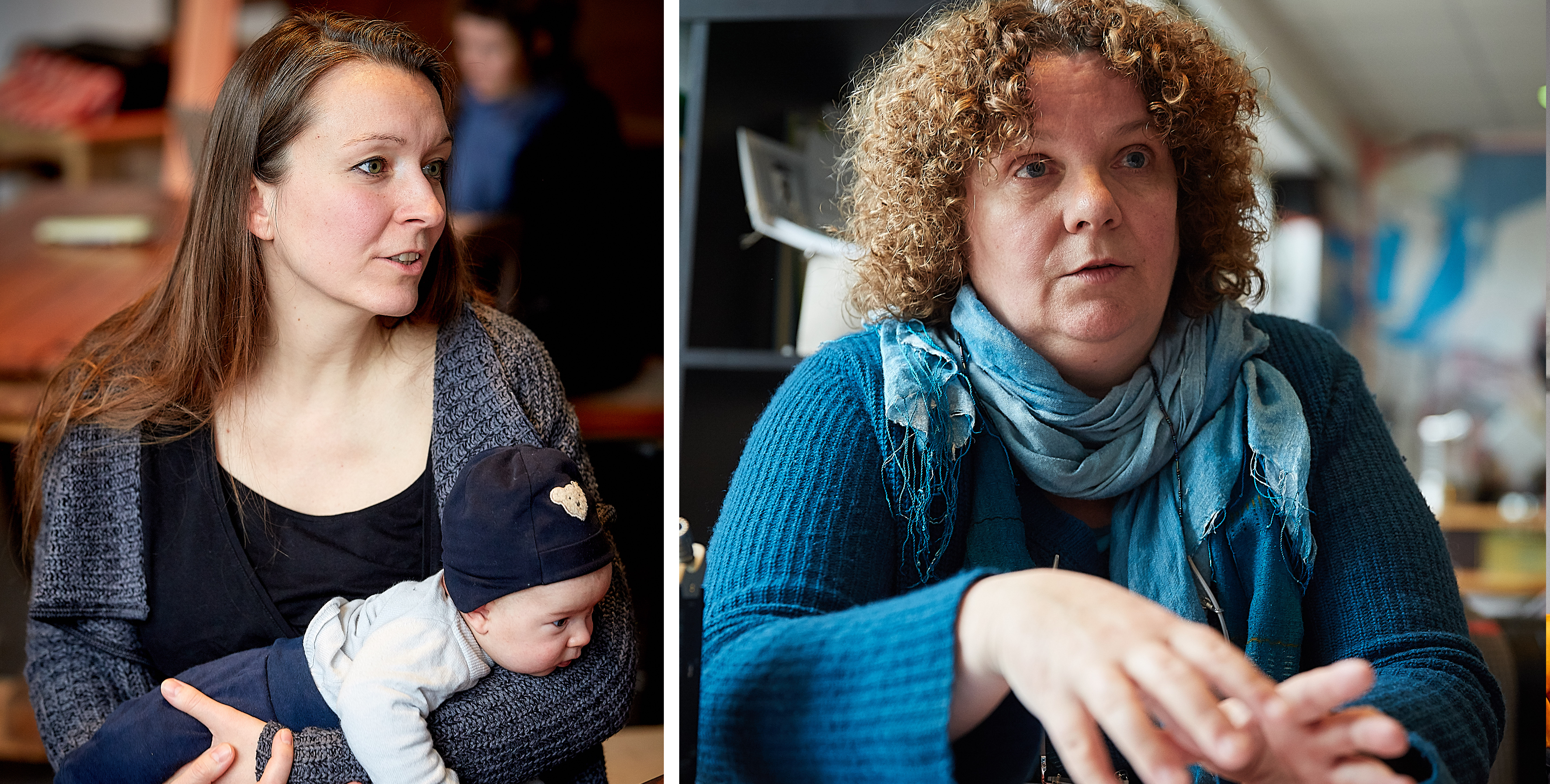
House of Resources helped to fund Salam-Kultur, the organization co-founded by Syrians and Germans that assists refugees with their daily lives, and it also supported OMAsCafe,65 a co-working space that hosts initiatives by and for refugees located in Holzmarkt, a new “urban village” founded by former owners of Berlin’s legendary nightclub Bar25.66 Some of the OMAsCafe initiatives have been successful, such as language classes, a carpentry workshop and information about consumer rights. Others, like a program run by Anke Wetzel to provide “one-to-one empowerment sessions” with women refugees, had a harder time gaining traction. Many women take primary responsibility for childcare and have a hard time finding time to look for work or training programs.
“What we experienced is that it’s super tough to do this because it’s super tough to get women,” said Wetzel at an interview at OMAsCafe while cradling her infant son. “They’re really caught up in their families. They have a lot of kids. If their husband’s not home, they’re not allowed to leave. So we tried to do it in the evening, but then the husband doesn’t want them to leave, wants them to look after the kids. So then we tried it in daytime but it was the same thing. So then we tried it with childcare. In the end we had about ten ladies but sometimes they come, sometimes they don’t come.”67
Schlesische 27 (S27),68 a nonprofit organization in the neighborhood of Kreuzberg dedicated to youth arts education, similarly has a vast gender imbalance (there are also overall more male than female refugees, though the ratio has improved since 2015).69 S27, which is funded in part by the state of Berlin and in part by private donors, worked with youth from socioeconomically burdened families for about thirty years before the refugees started arriving in large numbers. Today up to 90 percent of the 2,000 students taking part in the programs at S27 come from immigrant backgrounds. Most are between sixteen and twenty-seven years old and many came unaccompanied to Germany. The workshops teach a combination of skills, from carpentry to graphic design. Program coordinator Anton Schünemann said that the organization decided to focus its energies on refugees after a group of refugees and pro-immigration protesters set up a tent camp just down the street in Oranienplatz and staged protests about how the government was treating them. S27’s refugee students are mostly teenagers who have difficulties in school or have dropped out altogether.
“I have the sensation that the participants are getting way younger and that their social problems are getting worse. Because maybe now they are here for some time, and it doesn’t really go the way they want to; maybe also in the Syrian cases it gets more and more desperate with their families, and stuff like that. So especially for the young people it’s getting harder,” said Schünemann, referring to the difficulties many Syrians are facing with the family reunification process.70

The ReDI School of Digital Integration is a nonprofit “digital training school” that teaches coding to tech-interested refugees and other newcomers.71 Its most famous creation is an app called “Bureaucrazy,” created by a young Syrian named Munzer to help refugees (though now Germans use it too, he says) navigate German bureaucracy. All of ReDI’s teachers are volunteers, many of whom are foreign employees from the city’s booming tech startup industry. The ReDI staff is also majority foreign, with a Danish founder, three Syrians, an Italian, an Eritrean, an Egyptian, a Chilean, and an Albanian. It has gained international prestige since Facebook founder and CEO Mark Zuckerberg visited in 2016, followed by COO Sheryl Sandberg and Prime Minister Angela Merkel.
Abboud, a computer engineer from Aleppo who worked in the Middle East for ten years, has taken multiple courses at ReDI to brush up on his skills and to build his network so that he can find an apprenticeship. He is also continuing his German language study to bring his level up for employers.
“The job market in Germany is not that easy for foreigners, let us say it,” said Abboud, who speaks fluent English. “I’m one of the lucky people that the I.T. [information technology] language of business is English—but I’m still struggling with the bureaucracy and the mentality, to be honest.”72
In order to get a job in I.T., Abboud said, “you have to prove that you are professional enough, that you have the knowledge, that you can communicate. So you have some challenges: One of them is that your name is not German, another one is that you don’t have experience in Germany, the third one is the German language. If you find a recruiter with a foreign background, you are in luck.”
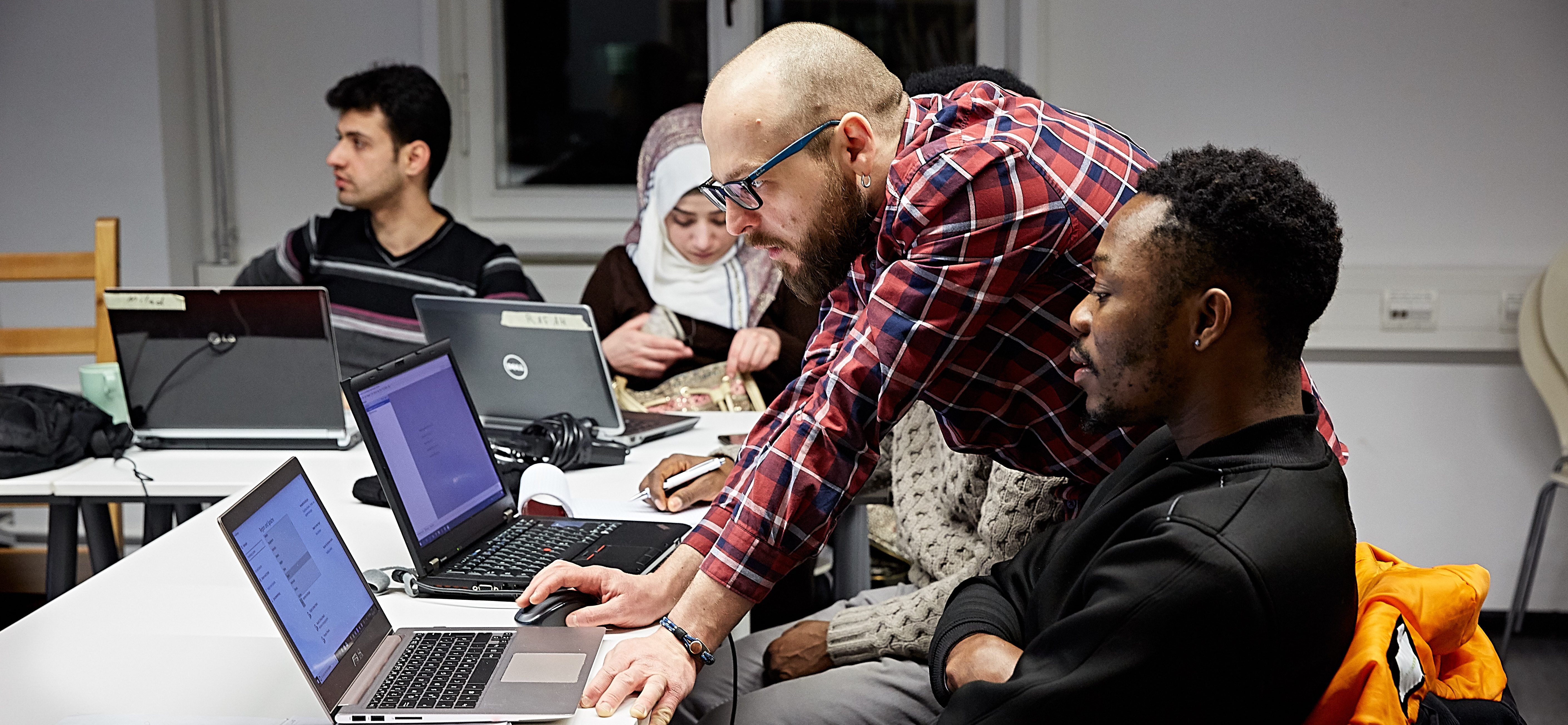
What Does “Integration” Mean to Germans and Syrians?
Just as language acquisition, labor force integration, and housing adequacy are going to take time, the process of Germans and Syrians getting accustomed to each other as compatriots will be lengthy. Some flashpoints became clear in conversations during the course of this research trip. For one, members of both communities complained about the paternalistic attitudes of the German government and many citizens toward the newcomers. All of the Syrians interviewed said they were grateful for the safety, financial support, education, and job opportunities provided by Germany, and many recognize that the government is making a more concerted effort to be systematic about integration than it did in the past. They also know that their cases are given more attention than other categories of refugees, like Afghans and those from the African continent, whose legal status is not as clear. However, many voiced resentment that Germans were trying to shape them as entirely new individuals, instead of recognizing their pre-existing skills and welcoming what they bring to German society.
Audio: Dancer Mohamed Alhalabi (“Wolf”), twenty-seven, from Damascus, is studying for a bachelor’s degree at Berlin’s University of the Arts, and rapper Tareq Assad, twenty-three, also from Damascus, will apply in the fall. Here Alhalabi and Assad speak about how their sense of home has changed, and the process of adjusting to the German way of life.
Moutasem Alkhnaifes, the Syrian who completed his master’s in urban planning in Berlin, said he felt that the overall approach by Germans was to have a “one-way conversation” with the refugees. “You just tell them what to do and what to be. You have to speak German, you have to go to the school, you have to do this and this and this and this to be able to succeed here. But I have never seen a person who is using his abilities that he already has.”
Alkhnaifes said that Europeans throughout history treated immigrants as “either evil people coming here with crimes, or people who are completely helpless.” That history, in his opinion, was repeating itself now with the Syrians in Germany. “Here it feels also the same,” he said, “like there are a lot of refugee places here, refugee housing, where people are not even allowed to cook for themselves because food is delivered every day. It’s like a free hotel service. You get free food, your bed sheets are washed. You just live and you don’t do anything. Because everybody is doing everything else for you. And then on the other hand you have people who are just feeling threatened by those refugees.”
Audio: Moutasem Alkhnaifes, twenty-eight, from Damascus, completed a master’s program in urban planning in Berlin. He is critical of the German approach to integration.
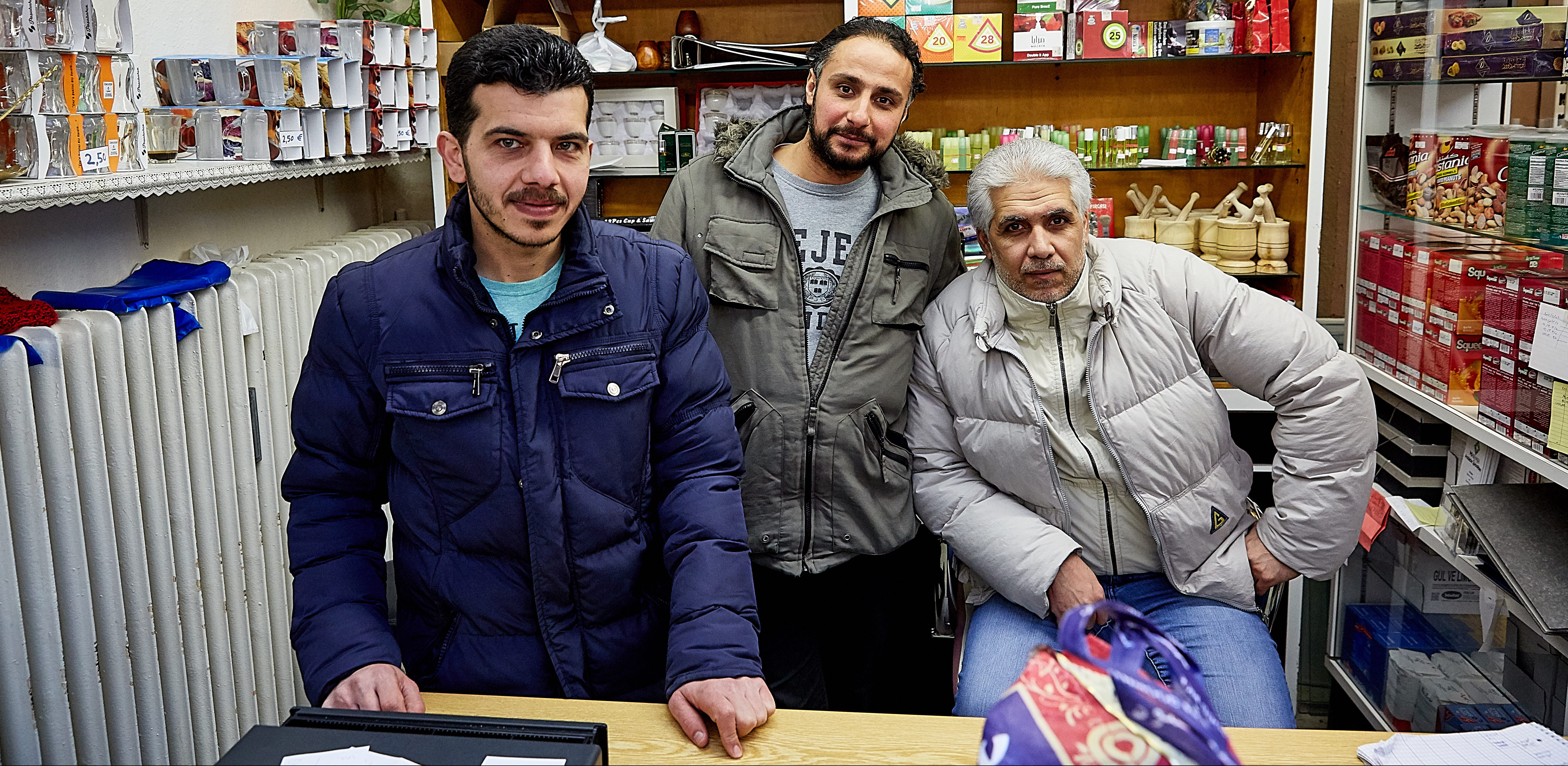
S27 executive director Barbara Meyer, who is also a member of the advocacy group Refugee Council Berlin, lamented the fact that refugees were blocked from contributing their own skills and talents in Germany.73 In the elaborate federal system of social support, as soon as someone applies for asylum, “you get some money, you get a bed, you have hundreds of dates with the administration, but you are completely cut away from any system of giving. You are not allowed to give because this is too dangerous. So it grows a very perverse situation. German society is angry about these people because they get everything, they come, they take everything, but… they also forbid them to give. They forbid them to work, to care for themselves, to develop step by step, ‘what can I do for myself, for my family.’”74
Audio: Barbara Meyer, executive director of the S27 arts education organization in Berlin, believes the refugee community is a valuable source of knowledge for Germans.
Alhalabi, the dancer at Berlin’s University of the Arts, said that he had been misrepresented by Germans who think they know what refugees need without even asking. “They say, oh refugees want this, refugees want that. And sometimes when I meet them, I’m one of the refugees, I say, ‘guys, it’s not like that.’ People, sometimes they present me in some ways… I say I am not like that. They say, ‘no I am supporting you,’ and I say, you’re not supporting me, the government is supporting me. You’re not supporting me: you are abusing the support.”
Another problem faced by the Syrians in particular is the pervasive fear—fanned by politicians, the media, and a number of attacks—that there are extremists among the refugees who are plotting attacks on the German population. Abdulrahman Alzghaer, a Syrian refugee from Deir ez-Zour who now lives in the small Bavarian town of Kaufbeuren with his wife Noura and their two-year-old son Abdullah, joked during a meeting of the Deutsch Stammtisch, or “German table,” that “the people here think we are all cousins of Osama bin Laden.”75
In fact, Jürgen Konrad, who volunteers with the Kaufbeuren refugee volunteer network “Arbeitskreis Asyl,” said that the first time Alzghaer showed up at a town hall and spoke up about issues in the refugee community, people in the audience whispered worriedly that he might be an extremist. “Amongst the German people in Kaufbeuren or anywhere, there’s a phobia of like, ‘oh god there might be an Islamic extremist or something,’” said Konrad.76
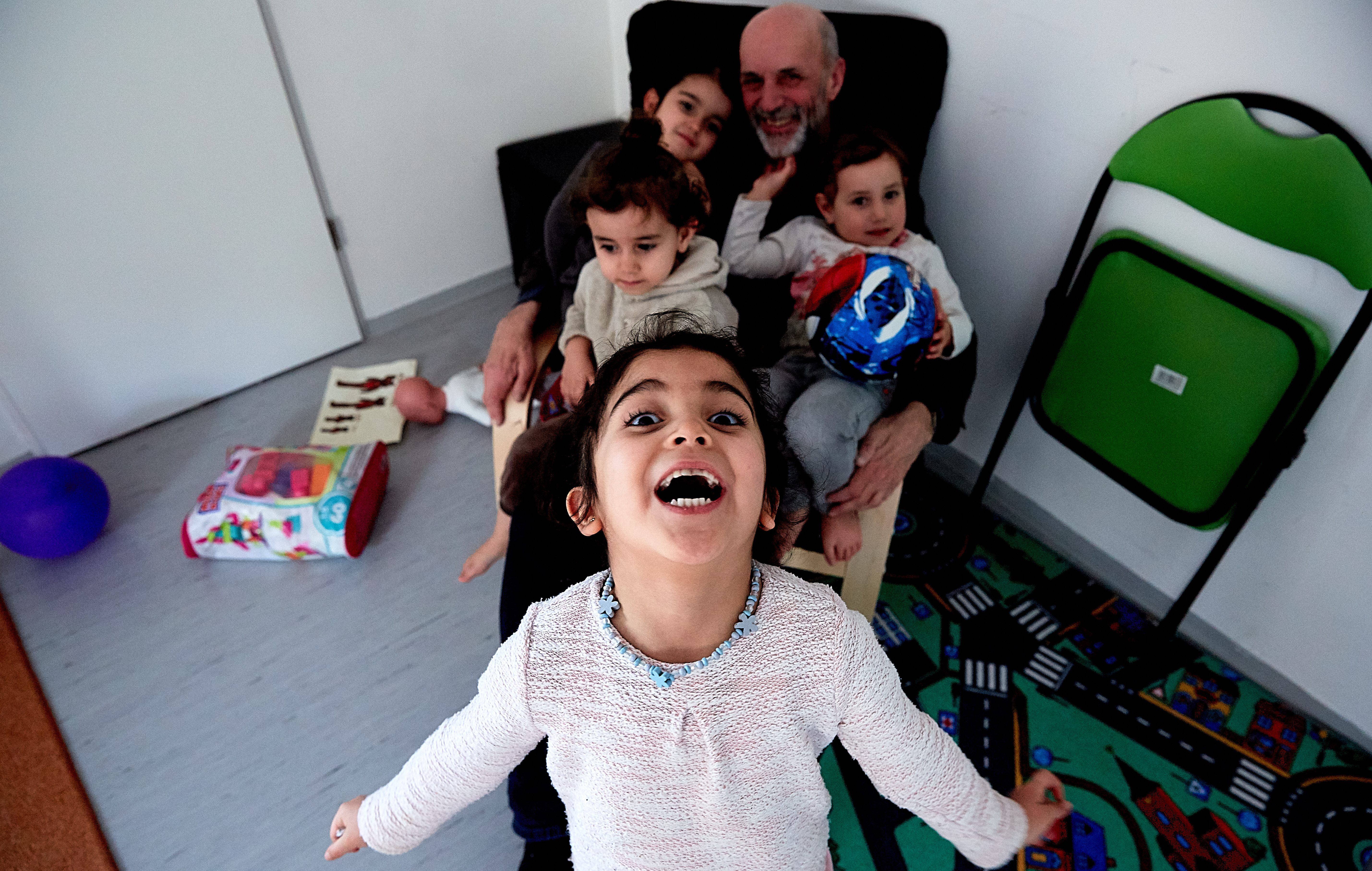
Audio: Wafaa Farok, from the al-Qadam neighborhood of Damascus, lives with her husband Asad Hawa, who is physically handicapped, and their two young daughters Seleen and Rewa, in dedicated refugee housing in Kaufbeuren. Here she discusses the challenges of finding a permanent housing and how her daughter easily transitioned to a German kindergarten.
Wafaa Farok, who came from the besieged al-Qadam district of Damascus with her handicapped husband and their two toddlers, is living in dedicated refugee housing in Kaufbeuren and struggling to find an independent place to live because of these prejudices. Farok and her family share a two-bedroom apartment with another Syrian couple in a large apartment building on the outskirts of the city.
“The problem here is the apartments. They’re expensive, and there are people who don’t want to rent to refugees. They’re afraid. They hear something bad about one person and it gives them a bad idea,” said Farok.77
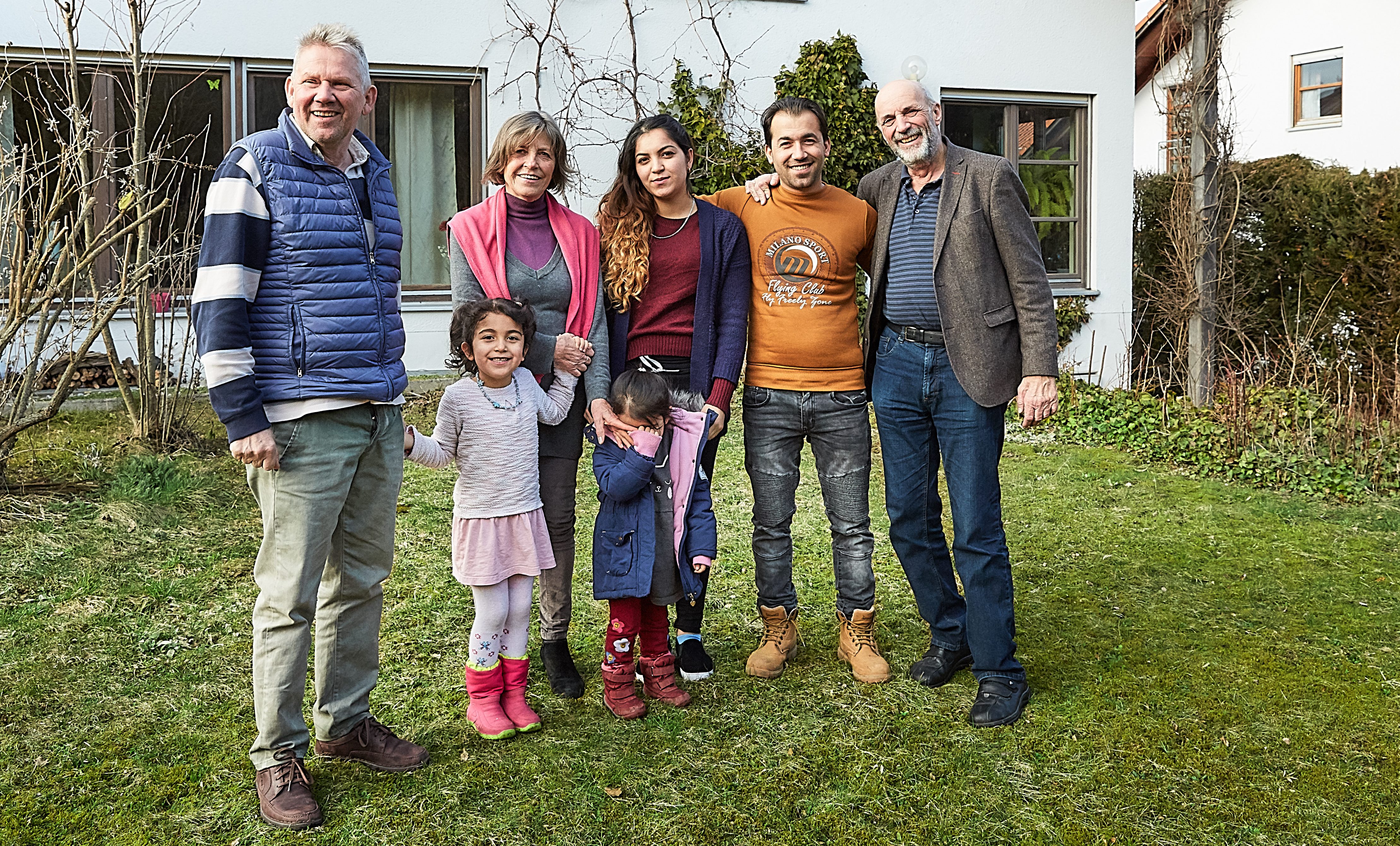
Audio: Klaus and Susan Silverberger talk about their experience renting several rooms in their Kaufbeuren home to a Syrian couple, Sawsan and Janbadan Suleiman, and their two young daughters.
The Alzghaers were fortunate enough to find a spacious, modern apartment in a quiet neighborhood in Kaufbeuren, which they rent from a Turkish landlord. But they had a very difficult time finding it.
“For Syrians, it’s impossible,” said Noura. “We went to see many flats and when the owner knows that we are Syrian he says no.”78
“There are so many reasons to say no,” added Abdulrahman. “We are on the welfare of the government, we are foreigners, we are Syrians. The spotlight is on the Syrian people—[people think] maybe they bring with them problems.”
Religion is very important to the Alzghaers, and Konrad said that there is an impression among the community in Kaufbeuren that Abdulrahman has become more conservative and influenced his friends in that direction. He is a leader in the refugee community, and with so much influence, some in the community are concerned that he does not shake hands with women, instead placing his hand over his heart—a common practice among Muslims—and his friends have begun to do the same. He also helped two other Syrians to open Kaufbeuren’s first halal market. Abdulrahman chalks up their fear to a conflation of religion and culture.
“I can follow the laws here,” said Abdulrahman. “But when the German people think about the man who hits his wife—it’s not Islam, it’s culture. They think all Muslims do the same. And hijab, it’s not culture, it’s religion. Not every Muslim woman wears a hijab.”
Alkhnaifes said he has witnessed a number of his fellow Syrians become more conservative since moving to Germany. “I’ve seen this kind of situation several times. It comes from this feeling that they are threatened culturally,” said Asem. “They feel they have to be a certain kind of person to be integrated into the community here—they feel that their culture is being taken away from them. And this is kind of a reflex because they feel like, okay, my religion is my culture. So I need to behave this way to maintain this characteristic that I already have. It’s not because they have better belief in God, it’s because they believe that those actions and those beliefs and that belief system will help them sustain themselves in this country. By being different.”
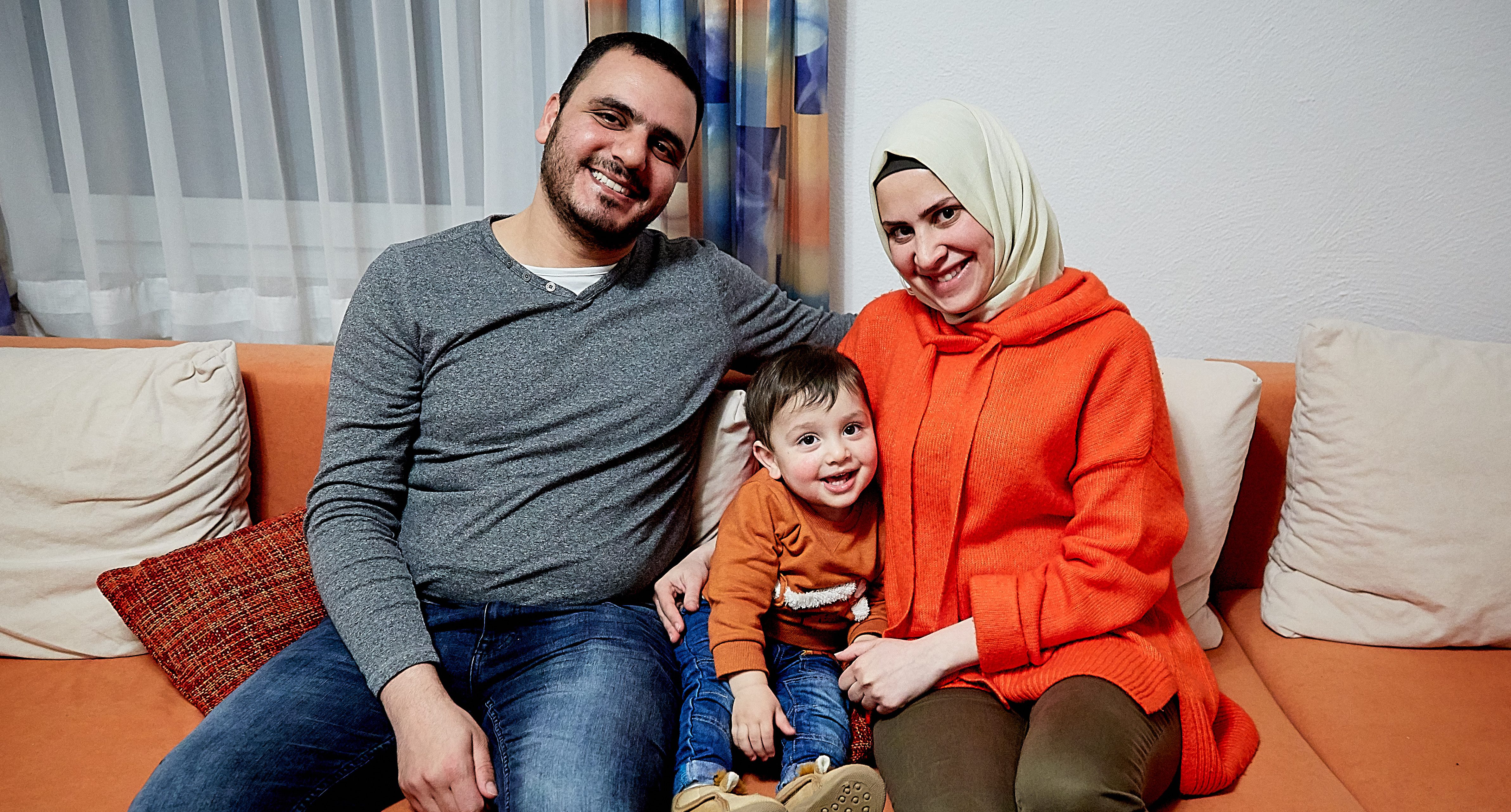
Abdulrahman’s wife Noura said that she had been told by multiple people, including her German teacher, that she should remove her hijab. “I think it’s difficult to have a job with a hijab. In Berlin especially. My teacher, she said, ‘Noura, you are beautiful, but without hijab. That is better.’”
The Alzghaers are taking the long view of their life in Germany. Abdulrahman was a protest organizer in 2011 and is wanted by the Assad regime’s security apparatus, which detained his brother accidentally while looking for him. The family hasn’t seen him since and assumes he was killed. So no matter how much Noura misses her family in Lattakia and wants to return, she knows that it is not realistic to go back to Syria with Assad in power. She was two months pregnant with their second child when we met in Kaufbeuren, and they spoke of a future in which their children never set foot in Syria. She said she liked the idea of her children growing up in Germany, as long as she can maintain her culture and religion from back home.
“Germany has many positive things,” said Noura. “On the other hand, for me it has—something I don’t like: it’s not in my religion, in my culture. I should have a balance between them for my children.”
Abdulrahman believes the Syrian community must make an effort to integrate in order to improve their outlook, and that of their children, for the future. He points to the Turkish model as one not to emulate.
“The mosques here, they speak Turkish, not Arabic, not German. We think, okay, you keep your tradition, but then there is a hole between you and the next generation. If you want to make this hole smaller, between us and our son, our son maybe he will not see Syria, he will not see our traditions… and if there is a big difference between us and the other people in the school, the parents of his friends, it will make a big problem. He will be two people a person with German people and [a different] person with his parents. But if we keep open-minded with connections, etc., he will grow up with [both] us and the community. Not alone.”
Audio: Syrians Abdulrahman Alzghaer and his wife Noura live in Kaufbeuren with their two-year-old son Abdullah in an apartment they rent from a Turkish landlord. Noura misses her family and wishes everyone could return to Syria, while Abdulrahman, who helped organize some of the first protests in Damascus and is vehemently anti-Assad, is committed to a future in Germany.
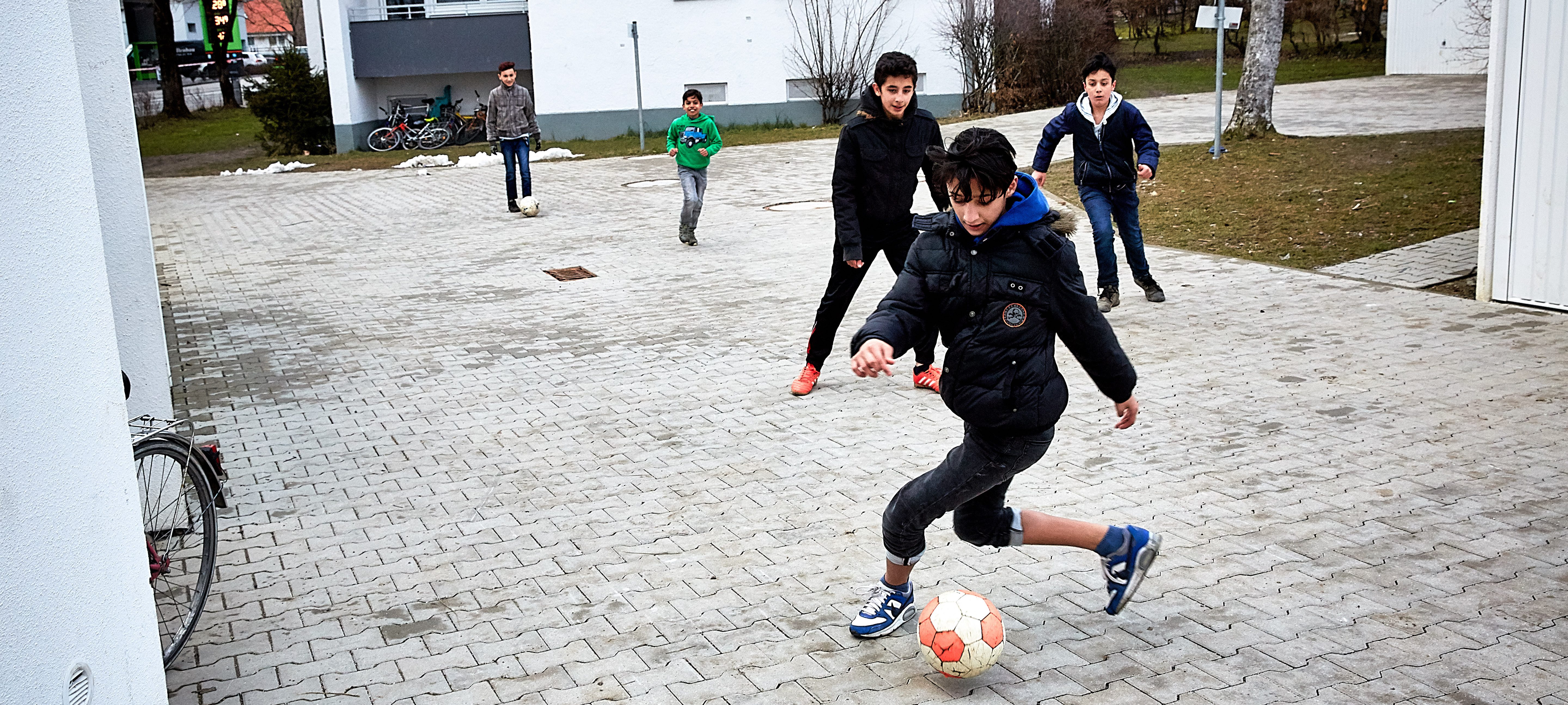
The Road Ahead
Just a few years into this experiment of workforce and societal integration, it is still too early to draw many conclusions. What’s clear, though, at this point, is that millions of people have invested in this project, hoping that it will withstand the nationalistic forces working against it. These efforts should be lauded. It is impressive to see what has been done so far, even if the particular systematic methods embraced by the German government are frustrating for the newcomers navigating their way through them. The flow of refugees of all nationalities to Germany decreased dramatically in 2017 and is reported to have continued to decrease in 2018, so, barring a reopening of large-scale conflict in Syria, there should be some less chaotic years ahead in which the communities will more easily be able to settle.79
Overall, the mammoth effort underway by the German government and civil society to absorb its refugee population offers an alternative option for the United States, where Muslim immigration is down 91 percent this year compared to 2016.80 The United States has long been the world’s top resettlement country for refugees, but the nation appears to be reversing course under the Trump administration.81 The downward trend of asylee admissions began under Obama,82 but under Trump, the country has drastically reduced the number of refugees being allowed in.83 After implementing an outright ban on refugees soon after taking office,84 part of his so-called “Muslim ban,” Trump lowered the cap on refugee admissions in FY 2018 to 45,000—its lowest in over four decades. Six months into the fiscal year, the administration had resettled only one-quarter of that number,85 and just forty-four of them were Syrian.86
Jürgen Konrad, from Kaufbeuren’s refugee volunteer network, is entirely invested in making this process work. He sees it as a historic opportunity for Germany as a nation. He was “proud and happy” that when he visited the United States in 2015, “for the first time people didn’t ask about Adolf Hitler but said, ‘oh wow, it’s great what you’re doing.’”
Tareq Assad, who is readying his application for the University of the Arts in Berlin this fall, said that problems remain and he still has a hard time making German friends, but he’s optimistic about the future of the Syrian community in Germany. “Germany presents for us a lot of opportunities in life. Of course it’s home for us. The place where you feel safe, and you eat. Arabs say when you eat with people for forty days, you become one of them.”
Abdulrahman Alzghaer, who has absolutely no hope of returning to Syria under Assad, said, “we will not be a problem. If they help us we will help to build this civilization. So I want to be a part of this civilization if I can. I will educate myself, I will educate my wife… this culture with our traditions, not separate. If I get my chances I will live happy in Germany.”
Acknowledgments
The author would like to acknowledge Wood Powell, managing director of the Transatlantic Outreach Program (TOP)—a public/private partnership of the Foreign Office of the Federal Republic of Germany, the Goethe-Institut, Deutsche Bank, the Robert Bosch Stiftung, and Siemens—for introducing her to some of the Germans interviewed for this report and facilitating her site visits to the vocational schools.
To view more photos from this research trip, please visit http://aarmasphotography.com/anewhope/.
Notes
- “EU migrant crisis: facts and figures,” European Parliament Press Service, June 30, 2017, http://www.europarl.europa.eu/news/en/headlines/society/20170629STO78630/eu-migrant-crisis-facts-and-figures.
- “Germany suspends ‘Dublin rules’ for Syrians,” Deutsche Welle, August 25, 2015, http://www.dw.com/en/germany-suspends-dublin-rules-for-syrians/a-18671698.
- Janosch Delcker, “The phrase that haunts Angela Merkel,” Politico, August 19, 2016, https://www.politico.eu/article/the-phrase-that-haunts-angela-merkel/. Original quote, in German, available in Merkel’s press conference transcript at https://www.bundesregierung.de/Content/DE/Mitschrift/Pressekonferenzen/2015/08/2015-08-31-pk-merkel.html.
- “Zahlen zu Asyl in Deutschland” (in German, translated into English using Google Translate), Federal Agency for Civic Education, May 16, 2018, https://www.bpb.de/gesellschaft/migration/flucht/218788/zahlen-zu-asyl-in-deutschland#Registrierungen.
- “Foreign population by selected citizenships,” Federal Statistical Office, https://www.destatis.de/EN/FactsFigures/SocietyState/Population/MigrationIntegration/Tables_ForeignPopulation/CitizenshipTimeSerie.html (accessed June 19, 2018).
- Michael Nienaber, “Labor shortages may undermine German economic boom: DIHK survey,” Reuters, March 13, 2018, https://www.reuters.com/article/us-germany-economy-labour/labor-shortages-may-undermine-german-economic-boom-dihk-survey-idUSKCN1GP109.
- “Family reunification for refugees resumes in Germany,” Deutsche Welle, August 1, 2018, https://www.dw.com/en/family-reunification-for-refugees-resumes-in-germany/a-44903743.
- Linah Alsaafin, “‘Blatant theft’: Syrians denounce Absentee Property Law,” Al Jazeera, May 9, 2018, https://www.aljazeera.com/news/2018/05/theft-syrians-denounce-absentee-property-law-180509140930804.html.
- John Burnett and Richard Gonzalez, “John Kelly on Trump, The Russia Investigation and Separating Immigrant Families,” NPR Morning Edition, May 10, 2018, https://www.npr.org/2018/05/10/609478998/john-kelly-despite-times-of-deep-frustration-no-regrets-taking-white-house-job?utm_campaign=storyshare&utm_source=twitter.com&utm_medium=social.
- David Bier, “U.S. Approves Far Fewer Muslim Refugees, Immigrants, & Travelers,” CATO Institute, April 23, 2018, https://www.cato.org/blog/us-approves-far-fewer-muslim-refugees-immigrants-travelers.
- Jeremy Diamond, “Trump says ‘there’s no reason to apologize’ for his Muslim ban call,” CNN Politics, April 30, 2018, https://www.cnn.com/2018/04/30/politics/trump-immigration-laws/index.html.
- Christopher F. Schuetze and Michael Wolgelenter, “Fact Check: Trump’s False and Misleading Claims About Crime and Immigration in Germany,” New York Times, June 18, 2018, https://www.nytimes.com/2018/06/18/world/europe/fact-check-trump-germany.html.
- “The labour market in May 2018,” Federal Employment Agency (Bundesagentur für Arbeit), Press Release No. 17, May 30, 2018, https://www.arbeitsagentur.de/en/press/en-2018-17-the-labour-market-in-may-2018.
- “Merkel says Germany must learn from its ‘guest worker’ mistakes for refugee crisis,” Reuters, September 9, 2015, https://www.nytimes.com/2018/06/18/world/europe/fact-check-trump-germany.html.
- “Turkish guest workers transformed German society,” Deutsche Welle, October 30, 2011, http://www.dw.com/en/turkish-guest-workers-transformed-german-society/a-15489210.
- Joseph Nasr, “Germany bets on second time lucky with migrant workers,” Reuters, August 18, 2017, https://www.reuters.com/article/us-germany-election-migrants-insight/germany-bets-on-second-time-lucky-with-migrant-workers-idUSKCN1AY1MZ.
- Author interview with residents of Kaufbeuren during bi-monthly Deutsch Stammtisch, or “German table,” at Generationenhaus, Kaufbeuren, Germany, March 21, 2018.
- “Initial Distribution of Asylum-Seekers (EASY),” Federal Office for Migration and Refugees, October 1, 2016, http://www.bamf.de/EN/Fluechtlingsschutz/AblaufAsylv/Erstverteilung/erstverteilung-node.html.
- Sarah Dryden-Peterson, Elizabeth Adelman, and Martina Nieswandt, “Inside Syrian refugee schools: Syrian children in Germany,” Brookings Institution, May 23, 2016, https://www.brookings.edu/blog/education-plus-development/2016/05/23/inside-syrian-refugee-schools-syrian-children-in-germany/.
- “Guide for Refugees,” Bayerischer Rundfunk, November 13, 2015, https://www.br.de/nachrichten/help-for-refugees-school-education-work-100.html.
- Guy Chazan, “Most refugees to be jobless for years, German minister warns,” Financial Times, June 22, 2017, https://www.ft.com/content/022de0a4-54f4-11e7-9fed-c19e2700005f.
- “Germany spent 20 billion euros on refugees in 2016,” Deutsche Welle, May 24, 2017, http://www.dw.com/en/germany-spent-20-billion-euros-on-refugees-in-2016/a-38963299.
- “Germany sees migration-related spending of 78 billion euros through 2022: report,” Reuters, May 19, 2018, https://www.reuters.com/article/us-germany-budget-migrants/germany-sees-migration-related-spending-of-78-billion-euros-through-2022-report-idUSKCN1IK0EG.
- Shekhar Aiyar et al, “The Refugee Surge in Europe: Economic Challenges,” International Monetary Fund, January 19, 2016, https://www.imf.org/en/Publications/Staff-Discussion-Notes/Issues/2016/12/31/The-Refugee-Surge-in-Europe-Economic-Challenges-43609.
- Federal Office for Migration and Refugees website (in English): http://www.bamf.de/EN/Willkommen/willkommen-node.html.
- Graeme Wood, “The Refugee Detectives,” The Atlantic, April 2018 issue, https://www.theatlantic.com/magazine/archive/2018/04/the-refugee-detectives/554090/.
- Bruce Katz, Luise Noring, and Nantke Garrelts, “Cities and refugees: The German experience,” Brookings, September 18, 2016, https://www.brookings.edu/research/cities-and-refugees-the-german-experience/.
- “Lagging economy in Germany’s former east risks stoking radicalism,” Reuters, September 6, 2017, https://www.reuters.com/article/us-germany-unity/lagging-economy-in-germanys-former-east-risks-stoking-radicalism-idUSKCN1BH1SE.
- Philip Oltermann, “‘Revenge of the East’? How anger in the former GDR helped the AfD,” The Guardian, September 28, 2017, https://www.theguardian.com/world/2017/sep/28/is-germanys-election-result-the-revenge-of-the-east.
- Arbeitskreis Asyl Kaufbeuren website (in German): https://www.arbeitskreis-asyl-kaufbeuren.de/.
- Author interview with Günter Kamleiter, Kaufbeuren, Germany, March 22, 2018.
- Salam-Kultur website (in German): https://salamkulturclub.de/.
- Media Residents Facebook page: https://www.facebook.com/mediaresidents/.
- “The German Vocational Training System,” Federal Ministry of Education and Research (in English), https://www.bmbf.de/en/the-german-vocational-training-system-2129.html (accessed June 19, 2018).
- Jenny Gesley, “Germany: Act to Integrate Refugees Enters Into Force,” Global Legal Monitor, Law Library, Library of Congress, August 15, 2016, http://www.loc.gov/law/foreign-news/article/germany-act-to-integrate-refugees-enters-into-force/.
- Andrew Soergel, “Trump Unveils Apprenticeship Overhaul,” U.S. News & World Report, June 15, 2017, https://www.usnews.com/news/articles/2017-06-15/donald-trump-unveils-apprenticeship-executive-order.
- “Ivanka Trump visits Siemens training center in Berlin,” press release, Siemens AG, April 25, 2017, https://www.siemens.com/press/en/pressrelease/?press=/en/pressrelease/2017/corporate/pr2017040279coen.htm.
- Kai Dambach, “Migrants filling apprenticeship gaps,” InfoMigrants, March 14, 2018, http://www.infomigrants.net/en/post/7940/migrants-filling-apprenticeship-gaps.
- A recent survey of German employers by the Organisation for Economic Co-operation and Development, Association of German Chambers of Commerce and Industry, and German Federal Ministry of Labour and Social Affairs showed that “at least good” German language skills were required for about half of all low-skilled jobs, and that increases to more than 90 percent for medium-skilled jobs. Language was the number one difficulty mentioned by employers hiring asylum-seekers, followed by a lack of vocational skills, different work habits, and uncertainty about the asylum-seeker’s length of stay in Germany. “Finding their Way: Labour Market Integration of Refugees in Germany,” Organisation for Economic Co-operation and Development, March 2017, https://www.oecd.org/els/mig/Finding-their-Way-Germany.pdf.
- Author interview with English teacher Meinke, who preferred not to give her last name, at Franz Oberthür Professional School, Würzburg, Germany, March 21, 2018.
- “Integration courses – what are they?”, Federal Office for Migration and Refugees, http://www.bamf.de/EN/Willkommen/DeutschLernen/Integrationskurse/InhaltAblauf/inhaltablauf-node.html (accessed June 19, 2018).
- “Migrants on the Waiting List,” Der Spiegel, October 25, 2010, http://www.spiegel.de/international/germany/integration-courses-migrants-on-the-waiting-list-a-725118.html.
- “Germany’s Ongoing Project to Welcome Its Refugees,” Der Spiegel, May 12, 2017, http://www.spiegel.de/international/germany/integrating-refugees-in-germany-an-update-a-1147053.html.
- Author interview with Wael Kojo and Steven Baur, Hörgeräte Baur, Kaufbeuren, March 22, 2018.
- Presentation given to author at Kaufbeuren state vocational school, using statistics from the Bavarian State Ministry of Education and Culture (Original, in German: Dr. Robert Geiger, “Qualitätsmanagement in den Berufsintegrationsklassen in Bayern,” Bayerisches Staatsminiterium für Bildung und Kultus, Wissenschaft und Kunst, page 7, http://www.qmbs-bayern.de/userfiles/Weiterentwicklung_QmbS-Runde1/01_Auftaktveranstaltung/03_Berufsintegrationsklassen.pdf.)
- Author interview with administrators at Franz Oberthür Professional School, Würzburg, Germany, March 21, 2018.
- Author interview with administrators at Franz Oberthür Professional School, Würzburg, Germany, March 21, 2018. All future quotations from Tutschku are sourced from this interview.
- Author interview with Markus Schiele at Staatliche Berufsschule Kaufbeuren, Germany, March 23, 2018. All future quotations from Schiele are sourced from this interview.
- Author interview with administrators at Franz Oberthür Professional School, Würzburg, Germany, March 21, 2018.
- Author interviews with students at Franz Oberthür Professional School, Würzburg, Germany, March 21, 2018.
- Author interviews during class visit at Staatliche Berufsschule Kaufbeuren, Germany, March 23, 2018. All future quotations from Derner are sourced from this interview.
- Ben Knight, “Sorrow, anger at Berlin’s LaGeSo refugee center after Syrian’s apparent death,” Deutsche Welle, January 27, 2016, http://www.dw.com/en/sorrow-anger-at-berlins-lageso-refugee-center-after-syrians-apparent-death/a-19007370.
- Author interview with Ahmad at Yasmin al-Sham restaurant, Berlin, March 18, 2018.
- Be an Angel e.V., “Be an Angel eröffnet Restaurant “Kreuzberger Himmel,” YouTube, August 27, 2017, https://www.youtube.com/watch?v=rSrnRXHv06I.
- Be an Angel website (in German, translated into English using Google Translate): https://beanangel.direct/about-us/.
- Author interview with staff at Kreuzberger Himmel restaurant, Berlin, March 18, 2018.
- Anna Katharina-Rich, “BAMF Brief Analysis,” Edition 3|2016, Federal Office for Migration and Refugees, http://www.bamf.de/SharedDocs/Anlagen/EN/Publikationen/Kurzanalysen/kurzanalyse3_sozial-komponenten.pdf?__blob=publicationFile.
- Stefan Trines, “Lessons From Germany’s Refugee Crisis: Integration Costs, and Benefits,” World Education News + Reviews, World Education Service, May 2, 2017, https://wenr.wes.org/2017/05/lessons-germanys-refugee-crisis-integration-costs-benefits.
- Stefan Trines, “Lessons From Germany’s Refugee Crisis: Integration Costs, and Benefits,” World Education News + Reviews, World Education Service, May 2, 2017, https://wenr.wes.org/2017/05/lessons-germanys-refugee-crisis-integration-costs-benefits (press release on €100 million investment, from Federal Ministry of Education and Research, in German: https://www.bmbf.de/de/fluechtlingen-den-zugang-zum-studium-ermoeglichen-1980.html).
- Author interview with Mohamed Alhalabi, Tareq Assad, Odah Bashi, and Yazan Albaour at University of the Arts Berlin, March 19, 2018. All future quotations from these people are sourced from this interview.
- German Academic Exchange Service website (in English): https://www.bmbf.de/de/fluechtlingen-den-zugang-zum-studium-ermoeglichen-1980.html.
- Author interview with Moutasem Alkhnaifes via Skype, March 29, 2018. All future quotations from Alkhnaifes are sourced from this interview.
- House of Resources Berlin website (in German): https://www.house-of-resources.berlin/ueber-uns/.
- Author interview with Dagmar Albrecht at OMAsCafe, Berlin, March 16, 2018. All future quotations from Albrecht are sourced from this interview.
- OMAsCafe website (in German): http://omascafe.de/omascafe/.
- Philip Oltermann, “The party city grows up: how Berlin’s clubbers built their own urban village,” The Guardian, April 30, 2017, https://www.theguardian.com/cities/2017/apr/30/berlin-clubbers-urban-village-holzmarkt-party-city.
- Author interview with Anke Wetzel at OMAsCafe, Berlin, March 16, 2018.
- Schlesische 27 website (in German): http://www.schlesische27.de/s27/.
- “Zahlen zu Asyl in Deutschland,” Federal Agency for Civic Education.
- Author interview with Anton Schünemann at S27, Berlin, March 15, 2018.
- ReDI School of Digital Integration website (in English): https://www.redi-school.org/.
- Author interview with Abboud, who preferred not to give his last name, ReDI School, Berlin, March 19, 2018. All future quotations from Abboud are sourced from this interview.
- Refugee Council Berlin website (in German): http://www.fluechtlingsrat-berlin.de/unserearbeit.php.
- Author interview with Barbara Meyer at S27, Berlin, March 15, 2018.
- Author interview with residents of Kaufbeuren during bi-monthly Deutsch Stammtisch, or “German table” meetings, at Generationenhaus, Kaufbeuren, Germany, March 21, 2018.
- Author interview with residents of Kaufbeuren during bi-monthly Deutsch Stammtisch, or “German table” meetings, at Generationenhaus, Kaufbeuren, Germany, March 21, 2018. All future quotations from Konrad are sourced from this interview.
- Author interview with Wafaa Farok in refugee housing, Kaufbeuren, Germany, March 23, 2018.
- Author interview with Abdulrahman and Noura Alzghaer at their apartment in Kaufbeuren, Germany, March 22, 2018. All future quotations from Abdulrahman and Noura are sourced from this interview.
- Jefferson Chase, “Refugee numbers in Germany dropped dramatically in 2017,” Deutsche Welle, January 16, 2018, http://www.dw.com/en/refugee-numbers-in-germany-dropped-dramatically-in-2017/a-42162223.
- Joel Rose, “Trump’s ‘Muslim Ban’ Is Already Happening, Immigrant Rights Advocates Say,” All Things Considered, NPR, April 24, 2018, https://www.npr.org/2018/04/24/605401393/immigrant-rights-advocates-say-the-muslim-ban-is-already-happening.
- “Resettlement in the United States,” United Nations High Commissioner for Refugees USA, http://www.unhcr.org/en-us/resettlement-in-the-united-states.html (accessed June 19, 2018).
- Katy Long, “Why America Could – and Should – Admit More Syrian Refugees,” The Century Foundation, December 16, 2015, https://tcf.org/content/report/why-america-could-and-should-admit-more-syrian-refugees/.
- Conor Finnegan, “Trump admits less than quarter of proposed refugees at six-month mark,” ABC News, March 30, 2018, https://abcnews.go.com/Politics/trump-admits-quarter-proposed-refugees-month-mark/story?id=54123008.
- Steve Almasy and Darran Simon, “A timeline of President Trump’s travel bans,” CNN, March 30, 2017, https://www.cnn.com/2017/02/10/us/trump-travel-ban-timeline/index.html.
- Conor Finnegan, “Trump admits less than quarter of proposed refugees at six-month mark,” ABC News, March 30, 2018, https://abcnews.go.com/Politics/trump-admits-quarter-proposed-refugees-month-mark/story?id=54123008.
- Deborah Amos, “The U.S. Has Accepted Only 11 Syrian Refugees This Year,” NPR All Things Considered, April 12, 2018, https://www.npr.org/sections/parallels/2018/04/12/602022877/the-u-s-has-welcomed-only-11-syrian-refugees-this-year.
